
SERENADE
On
scarlet roadside we stand with our eyes fixed on the sombre attic window which
opens not! Our sweet mistress named Lost History lifts not her veil! Time moves
not in gear reverse! Providence grants not serendipity to capture scenes past!
Our doleful ditty draws not response from La Belle Dame Sans Merci! In vain we
await a silver lining in cloudless sable! Wrench grows! Heart yearns for union
with merry mermaid!
Lo! Firmament splits! Down descends blithe spirit carrying
in its trail comment serene penned by McQueen.
While the Stars twinkle on the
firmament, non-sparkling Voids separate them from one another. While Hawks soar
in high sky, Snakes lie cramped in dingy crevices of the world.
History is
a record of collision of Titans and Pigmies, Swans and Ravens, Good Samaritans
and Heroes, Blood-Donors and BloodSuckers, Saviours and Killers, Healers and Cutthroats,
and Sacha Patshahs i.e. True Kings and Jhutha Patshahs i.e. FalseKings.
As
soon as Villains transform themselves into Heroes, global chaos will transform
into soothing cosmos.
But the long-awaited promised Millennium thus far remains
a vain dream.
No alchemist provides the philosopher's stone, which would gild
the iron shoes of sheep that graze pastures on slopes of valleys verdant and broad.
Pages
of history outpour more blood than salubrious herbal essence. Villains outnumber
Heroes.
We should love to inhale the part of history, which breathes healthful
fragrance.
In his Ramkali ki Vaar (M5) preserved in Guru Granth Sahib, the
third Guru Amardas makes a rhapsodic assertion:
'' Babanian kahanian put
sput karen!"
(Tales of glorious ancestors transform sons into dutiful
sons!)
It would seem that the discovery and joyous reading of pure part of
history would necessitate the expunction of the villainous part of it. To arise
as heroes, more than anything else we must know the history of heroes but it is
also necessary to know the negative performance of villains in the past so that
we should be able to eschew ugly deeds which people execrated in the past and
which they will execrate in the future too.
In our effort to sublimate our
lives, while we should select, accept and pick the gold in history, we should
identify and reject the dross.
Richard Wilson warns in the Preface to Lives
of Great Men published in 1911 in London that (as a binding onus on him) a great
biographer rivets attention on the 'crowded hour of glorious life' which won for
a man or woman a name to be remembered. In life there are great moments and small
moments. Maximum benefit accrues from concentration on momentous moments of lives
of great men.
Sir John W. McQueen's work is free from rigmarole.
McQueen
named his work The Kingdom of The Punjab - Its Rulers and Chiefs. However,
we have changed the title to Heroes and Villains of Sikh
Rule.
While creation of history is an arduous pursuit, preservation
of history is a rewarding job. If we do not learn lessons contained in available
annals, we shall be condemned to repeat the calamities, which we suffered in the
past. Our apathy to history incapacitates our visualisation and orientation of
forthcoming events. Study of past situations equips us to find mutatis mutandis
remedies to our present problems.
Loss of history due to negligence or accident
or prejudice remains a serious disadvantage.
Sir John W. McQueen completed
this work in 1894. Then his manuscript compilation comprising biographical
matter and pictorial representations slumbered in some niche for full sixteen
years. In the meantime McQueen passed away. On 1st May 1910 General Charles Pollard
contributed a short Foreword to late McQueen's work.
On 13th February 1994
we walked into the London's elfin grotto known as National Army Museum where we
fumbled for and found amid fervent jubilation McQueen's treasure chest.
From
1894 to 1994 teams of scholars from India came to United Kingdom, watched half-naked
men and women strolling and bathing on sun-lit beaches, delivered tall speeches
in lofty halls hired for them by seekers of fame and glory and returned to their
native country to tell their fellows the tales of 'research' picked by them from
domed British vaults. We wonder why the Providence reserved for us to unearth
and present to the world scholars the rare historical monument which had been
bequeathed by McQueen for detectives and diviners who would sniff at scrolls buried
very deep in valleys weird and enchanted.
O Cleo, on scarlet roadside we stand with gaze focused on sombre attic window! O beloved Muse, lead us to the treasure-troves buried under groves on brinks of rills or in burrows drilled in old hills. Amen!!
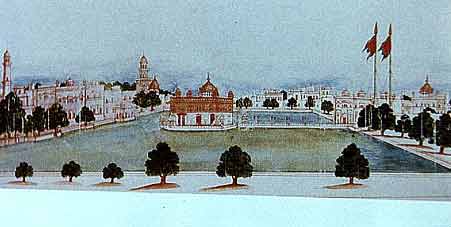
Amritsar,
the sacred city of the Sikhs, though boasting no great antiquity, is most picturesque
and striking.
The Sikhs may be described as dissenters from Hinduism bound
together by military ties: much of the ceremonial and formalism of Brahmanism
is rejected, including the most typical dogma of all, the worship of caste.The
sect owes its origin to Guru Nanak Shah, who preached this reformation towards
the end of fifteenth century. Their rulers, who eventually combined the functions
of military chief and spiritual leader, were called Gurus (Teachers) of whom the
tenth was the last.
At the beginning of the eighteenth century, the Sikhs formed
themselves into Misls (Confederacies), each (Misl functioning) under control of
a Sardar (or Chief)- These confederacies practically controlled the whole of Panjab.
But some hundred years
later all these Confederacies fell under the rule of
the famous Ranjit Singh, who died in 1839.-
After (Maharaja Ranjit Singh's)
death, a rapid succession of weak and incompetent rulers followed, accompanied
with much disorder, intrigue and considerable fighting between different faction
and parties.
The Sikh army now guided by its own self-elected Military Councils
became a law unto itself, and believing itself invincible determined on attacking
the British, driving them out of their northern possessions, and capturing and
plundering Delhi, against the old Muhammedan King (Bahadur Shah Zafar) and people
whom they owed a deep and dead religious enmity.
In December 1845, the Sikh
army crossed the Satluj, and commenced the hard fought Satluj Campaign. Finally,
the British victory at Sabraon in 1846, followed by that of Gujrat in 1849 resulted
in the (British) annexation of the Panjab.
Amritsar is a comparatively modem
city, having been founded in 1574 by Guru Ram Das. The chief attraction is the
famous Golden Temple built by (Guru) Ram Das (Guru Arjan -editor.) in the middle
of the lake (variously known as (Amritsar, Amritsarovar, Sudhasar and Sudhasarovar
term meaning) the Pool of Immortality."
Perhaps no temple in India possesses
so striking and beautiful a situation as this remarkable and sacred temple of
the Sikhs. In the dazzling sunshine, this beautiful sanctuary, with its burnished
copper gilt roof, shines like gold, while the lake is bordered with palaces of
wealthy Sikh chieftains with a background of shady groves gardens. From the mass
of greenery stand out, white and dazzling, soaring minarets, pinnacles and towers,
while the many coloured throngs of pilgrims on the terraces of the lake and the
marble causeway enliven the scene. The temple is reached by an arched causeway
inlaid with cornelians, agates and other stones. The Golden Temple stands on a
platform in the middle of the lake: it is a small building, and not of the slightest
architectural merit, but owing to the richness of its decoration and the unique
charm surroundings, it is (part of) one of the most attractive (complexes) in
India.
In the Temple sits the Chief Priest surrounded by a large number of
white robed priests, who sit round a large silken sheet piled with roses. The
Chief Priest chants a verse from the Granth, the Sikh Bible. The other priests,
musicians and devotees chant the alternative verses, while all the worshippers
file slowly past the Chief Priest in a reverent manner, sing and throw into the
silken sheet roses and other flowers as well as money from the smallest copper
to silver and gold pieces and occasionally jewellery. The whole ceremony is so
simple yet impressive that a visitor leaves the Golden Temple with a feeling that
he has not been looking at a sight, but at a reverent act of worship.
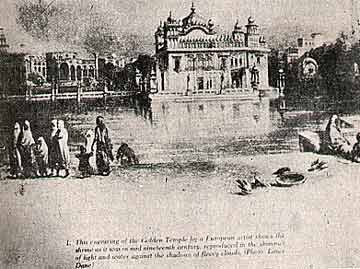
Another view of the Temple in the 19/20th centuries
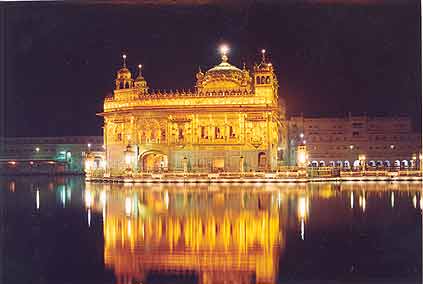
The present Grandeur of the Golden Temple or Harimandir Sahib
MAHARAJA RANJIT SINGH

In the respectable virtues, he had no part, but in their default he was still great. He was great because he possessed, in an extraordinary degree, the qualities without which the highest success cannot be attained. ... To the highest courage he added a perseverance which no obstacles could exhaust, and he did not fail in his undertakings, because he never admitted the possibility of failure.
Maharaja
Ranjit Singh was born in 1780. At the age of eleven, on the death of his father
Sardar Mahan Singh, Ranjit Singh became the nominal chief of the Sukarchakia Misl.
When sixteen, he killed his mother for infidelity to the memory of his father.
In
1797, at the age of seventeen, he assumed the leadership of Sukarchakia Misl,
and soon showed his military qualification and great aptitude for command by leading
his men, first against his Muhammedan neighbours, and afterwards, as his followers
increased, against some of the weaker Sikh Misls.
When Shah Zaman of Kabul
invaded the Panjab for the last time, he appointed Ranjit Singh, in 1799, as the
Governor of Lahore. (Maharaja Ranjit Singh had captured Lahore on 7th July 1799,
therefore the 'appointment' by Shah Zaman is wrong - Ed,) Ranjit Singh soon firmly
established his authority in that city and its neighbourhood: and in 1801, having
assumed the title of Maharaja, proceeded by force and craft gradually to subdue
the Sikh Misls north of Satluj. By degrees, he extended his rule all over the
Panjab, and the Himalayan Mountains bordering it, including Kashmir and Ladakh,
as well as to the foot of the mountains on the Afghan border.
Ranjit Singh's
reign was a long campaign in consolidating his power of which it is impossible
to give any account here.
Ranjit Singh was a far-seeing man who never wavered
in his loyalty to the Treaty he made with the British Government, well comprehending
its great power, and fully trusting that as long as he abided by the terms of
the Treaty, the British Government would also do so and would not interfere with
him.
Although short of stature and disfigured by smallpox by the loss of one
eye, Ranjit Singh was an ideal soldier, strong, aware, active, courageous and
enduring, an excellent horseman, keen sportsman and an accomplished swordsman.
He
was quite uneducated, could neither read nor write, but had a marvellous memory.
Ranjit
Singh had an unusually large share of the weaknesses and vices in human nature.
Ranjit
Singh was selfish, false and avaricious; grossly superstitious, shamelessly and
openly drunken and debauched.
In the respectable virtues, he had no part, but
in their default he was still great. He was great because he possessed, in an
extraordinary degree, the qualities, without which the highest success cannot
be attained.
Ranjit Singh was a born ruler with the natural genius of command:
men obeyed him by instinct because they had no power to disobey him.
To the
highest courage he added a perseverance which no obstacles could exhaust, and
he did not fail in his undertakings, because he never admitted the possibility
of failure.
He possessed the faculty of choosing his subordinates well and
wisely, and consequently he was, in a corrupt and violent age, wonderfully well
served.
His natural avarice and rapacity were tempered by his appreciation
of the advantages of generosity in rewarding good services. With all his rapacity,
Ranjit Singh was not cruel or bloodthirsty, and after a victory or capture of
a fortress he treated the vanquished with leniency and kindness. To cite an instance
of his rapacity, by means of most unscrupulous methods, he compelled the fugitive
King of Kabul Shah Shuja, then his guest at Lahore, to give to him the celebrated
Koh-i-Nur diamond.
Although sharing in full the course vices of his time, he
yet ruled the country, which his military genius had conquered with a vigour of
will and ability, in such way as placed him in the first rank of the statesmen
of the century.
The six years, which followed Ranjit Singh's death in 1839,
were a period of storm and anarchy, in which assassination was the rule and the
weak were trampled under foot.
The Kingdom founded in violence, treachery and
blood did not long survive its founder. Created by the military and administrative
genius of one man, it crumpled into powder when the spirit, which had given it
life, was withdrawn.
The death of Ranjit Singh, in fact, was followed by a
series of crimes and tragedies such as had rarely paralleled in history, save
in the darkest days of downfall of Rome, or in the early days of the French Revolution.
At
Ranjit Singh's funeral obsequies, one of his wives and three ladies of his zenana
of the rank of Rani were burnt with him.
Maharaja Ranjit Singh married eighteen
wives, nine by the orthodox ceremonial, and nine by the simpler rite of throwing
the sheet. The Maharaja had many reputed sons, but only one legitimate one, Kharak
Singh, who succeeded him.
COMMENTS
In
his work 'Ranjit Singh' Khushwant Singh quotes Lieutenant Bennett's English translation
of Shah Shuja's autobiography containing the deposed Afghan King's personal evidence
to the effect that privation of necessaries of life, occasional placement of Lahore
Durbar guards around his abode and interdiction on his visiting his zenana comprised
the measures resorted to by Ranjit Singh to coerce him to part with Koh-i-Nur.
Cf.
A. S. Baaghaa's Panjabi work Mahabali Ranjeet Singh:
On 27th June 1839, the
crest-fallen Ranjit Singh lay on bed. Bhai Gobind Ram whispered into his ears:
"O bread-giver, pronounce Ram, Ram, Ram." Ranjit Singh's lips moved
twice. A third effort to invoke Ram bore no fruit. The swan fluttered away from
the elemental cage. Dolorous shrieks arose from zenana. The Maharanis pulled their
hair and beat their heads on walls. The sun sank down the western horizon. Despondency
lurked in the air. Sikh hymnists hummed verses of Guru Granth: Brahmans, on their
part, pronounced Gita's text. On 28th June 1839, Kharak Singh put on dhoti round
his waist and poured gangajal on his dead father. Ranjit Singh's spouse Hardevi
reminded Vizier Dhian Singh of his pledge that he would accompany his master in
his journey to the next world. Clad in new garments, Dhian Singh ran to his master's
pyre. Kharak Singh put his turban.
on Dhian Singh's feet and said: "Please
do not die, because at this distressful hour, we have none else who can steer
ashore the governmental barge."
While Maharani Gaddan walked to her dead
husband's pyre, she begged Dhian Singh to stand by Kharak Singh for a year. She
told him that thereafter he would be at liberty to itinerate to holy places. Gaddan
sat in the centre of the pyre. She placed Ranjit Singh's head on her thighs. Gaddan,
Hardevi and two more Maharanis formed the inner ring of Satis. Seven handmaids
sat behind them on the pyre. Maharani Gaddan placed Dhian Singh's hand on Ranjit
Singh's breast. "Remain faithful to Kharak Singh," she said. She spoke
out to Kharak Singh: "Abide by Dhian Singh's counsel." Kharak Singh
set the pyre aflame. Maulvi Ahmad Bakhsh Chishti' Yakdil' reports that at that
time the clouds sent down soft shower as send-off to the fairies who burnt on
pyre. Two pigeons descended from sky and joined the dead Maharaja's partners in
their fervent homage to the Lion of Panjab.
Fourteen creatures comprising one
man, eleven women and two pigeons were together consumed by tongues of fire, which
arose heavenward. McQueen wrongfully reduces the self-immolators to a mere pentad.
Waheeduddin,
op. cit., basing his information on heirloom record, makes no secret of it that
Ranjit Singh's exploits on bed involved as many as forty-six women comprising
regular wives, widows, handmaids and concubines.
In his work, A History of
the Sikh People, Gopal Singh observes that the British writers perhaps conspiratorially
denigrated Ranjit Singh's sons as illegitimate and that some modern Hindu and
Sikh scribes followed suit. Jagjiwan Mohan Walia quotes Foreign Consultations
Record preserved in National Archives of India while he observes in his work,
Parties and Politics at Sikh Court: 1799-1849, that in 1827 Kharak Singh wrote
a letter to the Governor of Bombay Mountsruart Elphinstone, soliciting British
government support against Prince Sher Singh in his candidature for inheriting
Maharaja Ranjit Singh's power and pelf. Jagjiwan Mohan Walia affirms that in the
aforesaid letter Kharak Singh declared that Sher Singh and Tara Singh were not
real sons of Maharaja Ranjit Singh. The letter was signed by Kharak Singh's son
Nau Nihal Singh also. Thus the scandalous infamy of Ranjit Singh's sons sprouted
from the ambitious rivalry of Kharak Singh and Sher Singh each of whom wanted
to steal march on other to seize Lahore throne. Each got the coveted lofty status
only to lose the same in miserable premature demise.
Towards the end of 1826,
Maharaja Ranjit Singh became seriously ill. Of course, the matter of his father's
recovery was of no higher concern to Kharak Singh than his own installation as
the Ruler of Lahore in the event of his father's malady assuming mortal proportions.
This explains the background of the aforesaid correspondence addressed by Kharak
Singh to Elphinstone in regard to the formers pre-emptive claim to sovereign monarchy
of Lahore on the ground of his supposed
half-brothers Sher Singh and Tara Singh
having not been born in lawful wedlock.
The pure mind scans merit rather than
birth as the succession criterion. Guru Nanak chose his devotee Angad as his successor
because the latter rather than the formers sons mirrored the
The psyche and
ethos of Guru Nanak. Literally, the term Angad means one born of limb' i.e. son.
In Guru Nanak's logic, the son is born of the father's spirit rather than his
physical frame.
The ideal son would not clamour for patrimony: nor does ideal
dad deny privileges to the dutiful son.
Unfortunately, the reigning family
of Lahore failed to imbibe the principles of Guru Nanak. The inevitable result
was that they indulged in internecine spite and ruined themselves.
MAHARANI JINDAN
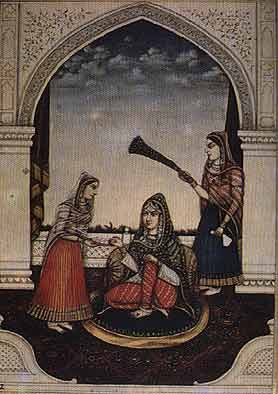
Maharani
Jindan, the mother of Dalip Singh, was the daughter of a common trooper in the
service of Ranjit Singh.'
Jindan attracted the attention of the old Maharaja,
as a clever mimic and dancer, and was taken into his zenana, where her open intrigues
caused astonishment in the Court of Lahore.
A menial servant, Gullu, a water-carrier,
was generally accepted as the father of Dalip Singh: at any rate, the father was
not Ranjit Singh who was paralysed several years before the birth of the child
nor did he ever marry Jindan by formal or informal marriage.
In the wild anarchy
which succeeded the murder of Maharaja Sher Singh, Jindan, with her last professed
lover, Raja Lal Singh played a conspicuous and infamous part, and they both were
in a great measure the cause of the Satluj War, and the ruin of the Sikh Kingdom.
In
1848, before the annexation of the Panjab, Jindan banished to Hindustan, on account
of the prominent part she took in a conspiracy against the British Resident. She
was eventually allowed to go to England, where her son Dalip Singh had been provided
with a home.
Jindan died in England in 1863, aged 46.
COMMENTS
Jindan was born in 1817 in a village about three miles to southwest of Gujranwala
in present Pakistan. Her father named Manna Singh Aulakh was actually Maharaja
Ranjit Singh's kennel-keeper, later raised as chamberlain.
Manna Singh Aulakh was a humorist in Lahore Durbar. When Jindan was eleven years
old, Aulakh, waggishly and suppliantly, suggested to Maharaja Ranjit Singh that
he wondered whether his darling daughter would in due course blossom into an exuberant
decoration-piece worthy of adorning that mighty monarch's bedchamber.
Jindan
dextrously developed her innate potential for growing into an adept nautch-girl.
Her voluptuous exterior made her the focus of many a longing eye.
We learn
from Memoirs of Alexander Gardner, that Ranjit Singh took Jindan into his harem
where the little beauty used to gambol, and frolic and tease and captivated the
Maharaja in a way that smote the real wives with jealousy. In 1830, with the object
of calming the jealousy of his wives, the Maharaja sent Jindan, then thirteen,
to her godfather at Amritsar where her amorous glances and coquettish pranks continued
attracting lustful attentions of no small number of erotic truants.
At long
last, Jindan's godfather begged of Maharaja Ranjit Singh the permission for escorting
the wayward damsel back to Lahore.
Contrary to Sir John McQueen's observation
that Ranjit Singh never married Jindan formally or informal ly, the work Flashman
and the Mountain of Light, based on The Flashman Papers 1845-1846, and edited
and arranged by George MacDonald Fraser, affirms that in 1835 Jindan went through
a form of marriage with Ranjit Singh.
Maharaja Ranjit Singh had first paralytic
attack in July 1835. In December 1838, amid festive entertainment of the British
Governor-General of India, Lord Auckland, during the latter's visit to Lahore,
the Maharaja was gripped by a second paralytic attack.
The Flashman s Papers
referred to above suggest that Jindan's exuberant charms possibly turned the smouldering
sexual ash within Ranjit Singh into a virile storm and that on this count Dalip
Singh was probably a legitimate son of the Lion of Panjab.
The motive of the conspiracy alluded to by McQueen was the murder of the British
Resident at Lahore Lt. Col. Hen Lawrence and his henchmen. The plan, which had
the secret, and hence non-provable sanction of Jindan, aborted because of its
unfortunate leakage. In August 1847, Maharani Jindan was removed to Shekhupura
Fort. In May 1848, accompanied by pro-British hostile escort she left that fort,
crossed the Satluj to Firozpur and moved to Banaras Fort to rot in confinement.
In April 1849 she was taken to Chunar Fort. From there Jindan escaped out in the
guise of a seamstress. After that her journey in the false appearance of a Bairagan
terminated on her entry in Nepal where her request for asylum elicited a warm
response. There she lived in Khatmandu on the bank of the Rill known as Vegmati
while scenes of lost glory recurrently flashed on her inner screen. Towards the
end of 1860, Dalip Singh specially journeyed to India to bring his mother to England.
Dalip Singh's erstwhile Tutor and Guardian, Sir John Login, secured a house for
Maharani Jindan on Lancaster Gate in London. Login himself lived in the house
then called No. 1 Round-the-Corner. This was only one house between Login's residence
and the house procured by him for Jindan. In mid-1862, Jindan occupied Abingdon
House in Kensington in London where she lived till death. In this connection,
the work entitled 'The Tablet', dated back to 10th April 1875, and preserved in
London's Colindale Library provides the following information on its page 454:
...
the mansion was occupied by the widow of a ce-devant Indian potentate of high
rank, with her Hindoo servants and retainers. A local rumour, which we are unable
to confirm or contradict, says that during the residence of the Ranee at Abingdon
House, it was the scene of Hindoo religious ceremonies, and even of sacrifices,
that were practised by the inmates. It this was really the case, the lustration
which the house and grounds must have undergone, it being now devoted to Christian
uses, must have sufficiently purged away all taints of diabolic fraud and pagan
superstition.
The publication Survey of London, Volume XLll, Greater lLondon Council, 1986 refers to The Tablet, reproduces a partof its above extract and adds that in 1720 the site of Abingdon House was acquired by Sir Isaac Newton, that in c. 1838 a tenant of some standing, named the Fourteenth Lord Teynham resided there, that in 1861-62 Mamaduke Wyvill, M.P., was tenant in it and that at one stage, perhaps after Wyvill, the house was occupied by the widow of a ce-divant Indian potentate.
The exact date of Jindan's death is 1st August 1863. George MacDonald Fraser is wrong while he observes op. cit. p. 370 that Dalip Singh took his mother's ashes to India: he took her dead body to India, not her ashes. After Jindan's death, her dead body was stored in a vault in Kensal Green Cemetery in London. In mid-February 1864, the body was exhumed for taking it to India. There it was cremated at Nasik whereafter the ashes were scattered on the waters of Godavri. After her banishment from Panjab, Jindan, alive or dead, was denied return to Punjab.
McQueen s account omits some quite important events. He does not notice that on Dalip Singh's coronation in September 1843, Jindan and her brother Jawahar Singh arose as Joint Regents to him. Nor does he mention Jindan's dismissal as Regent towards the end of 1846.
MAHARAJA KHARAK SINGH
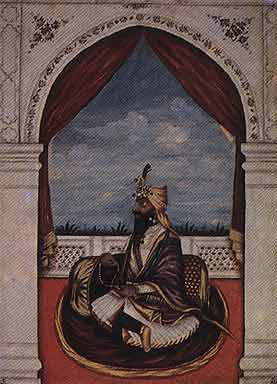
Kharak Singh, the only legitimate son of Ranjit Singh, succeeded his father as Maharaja in 1839.
Under the influence of Sardar Chet Singh, a court favourite, the late (Maharaja Ranjit Singh's) Minister, Raja Dhian Singh, was ignored and insulted, and a plan made to assassinate him. But this coming to the Minister's knowledge, he resolutely formed a Coalition with some Chiefs and Maharaja Kharak Singh's only son, a capable youth of fiery and ambitious temper. They circulated a rumour that Kharak Singh contemplated submission to the British Government when the Sikh army would be disbanded. This powerfully appealed to the soldiery, who consequently looked upon the Maharaja as a traitor to his country.
The Minister, with his adherents, entered the palace before sunrise, cut down the Royal Guards, penetrated to the private apartments and killed the obnoxious favourite (Chet Singh) in the presence of his Master (Kharak Singh).
After a reign of three months, Kharak Singh was deposed, and his son Prince Nau Nihal Singh placed on the throne.
The deposed Maharaja died the following
year, not without suspicion of poisoning, and his son (Nau Nihal Singh), while
returning from his father's obsequies, mysteriously met his death by what is called
an accident.
The designing Minister Raja Dhian Singh now outwardly supported
the claim of the Queen Mother Chand Kaur to govern as Regent (to the child which
late Nau Nihal Singh's pregnant widow would deliver), but secretly he inspired
Prince Sher Singh advance his claim to throne as a reputed and acknowledged son
of Ranjit Singh.
COMMENTS
In conformity with Maharaja Ranjit Singh's wish, Kharak Singh was anointed as his successor on 21 st June 1839 six days before the formers death.
Chet Singh was a Bajwa Jat. He was a close relative of Kharak Singh's brother-in-law Mangal Singh Sandhu. While he was obstinate, fastidious, avaricious and arrogant, he was much less shrewd and much less wily than Raja Dhian Singh whom he wished to supersede through sycophantic and panegyric acting before Kharak Singh. Bajwa oft resorted to boastful threats as means to cow down his rival Dhian Singh.
On 8th October 1839, during night Dhian Singh and his adherents, namely, his two brothers Gulab Singh and Suchet Singh, Prince Nau Nihal Singh whose counsel his father Kharak Singh had, of late, been apathetically disparaging, Treasurer Lal Singh, Col. Alexander Gardner, Suchet Singh's Adviser Rai Kesri Singh and the leading Sandhanwalia Sardars entered the royal palace for soiling their hands with the blood of Bajwa whose influence on the mentally retarded Kharak Singh was foiling every attempt of Prince Nau Nihal Singh to retract him from fallacious policy.
As yet Nau Nihal Singh was at the most a self-appointed Regent and by no means a de jure Maharaja. In native accounts his name is invariably prefixed by Kanwar i.e. Prince.
Kharak Singh died on
5th November 1840. While Nau Nihal Singh and Gulab Singh's son Udham Singh walked
back together after the antam ardas or last prayer at the cremation of dead body
of Kharak Singh, the archway under which they walked gave way. The impinge of
stones which pelted down killed Udham Singh on the spot and wounded Prince Nau
Nihal Singh above his right ear. The Prince staggered down, made an effort to
rise and demanded water. Nau Nihal Singh was carried into the palace. In vain
the Prince's sad and furious mother beat the fort gateway which Dhian Singh kept
shut on Nau Nihal Singh's kith and kin.
The contemporaneous evidence preserved
in Memoirs of Alexander Gardner and in Dr. J. M. Honigberger's Thirty-Five Years
in the East, H. Bailliere, London, leads us to conclude that what the collapse
of archway failed to attain was achieved by Dhian Singh's recourse to homicide.
The Kanwar met death while on way to investiture as Maharaja! None demanded or
ordered enquiry into the grievous tragedy. Dhian Singh's uncharitable refusal
to admit Nau Nihal Singh's mother Chand Kaur to the palace to enable her to tend
her wounded son is in itself an adequate evidence of his sinister motive. At the
same time Chand Kaur's failure to storm the gate to gain access to her son proves
her utter resourcelessness.
MAHARANI CHAND KAUR
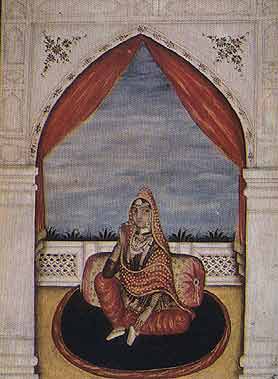
Chand
Kaur, daughter of Sardar Jaimal Singh Kanhaiya of Fatehgarh near Gurdaspur, married
Maharaja (then Kanwar or Prince) Kharak Singh in 1812. The marriage was celebrated
with great splendour, and General (Sir David) Ochterlony attended the ceremony.
In
1821 Maharani Chand Kaur gave birth to her son Nau Nihal Singh.
On the deaths
of her husband Kharak Singh and her son Nau Nihal Singh, both on 5th November
1840, Chand Kaur laid claim to Sikh crown.
Chand Kaur's claim was supported
by the powerful Sandhanwalia Sardars, and also by, as she thought, Raja Dhian
Singh, the Prime Minister, who was, however, only deceiving her, as he was actually
working at that time on behalf of Prince Sher Singh.
The Minister's elder brother
Raja Gulab Singh, with his troops fought for Chand Kaur, and held the Fortress
of Lahore against Prince Sher Singh and the Sikh army during five days' hard fighting.
[On
its surrender (i.e. surrender of Fortress) Chand Kaur renounced her claim to the
Sikh throne.
The Dogra brothers. Rajas Gulab Singh and Dhian Singh Apparently
often espoused opposite sides, but they were secretly forking in unison, for their
armies were common. (Their inner motive was advancement of themselves and their
kindred to wealth and power, at all hazards)
In 1842 Maharani Chand Kaur was
murdered by her own slave girls to whom she had been inordinately cruel. They
beat her to death with their own slippers. Dhian Singh and Sher Singh are believed
to have instigated the slave girls, by giving them money and promising them further
rewards, to kill their mistress, whom it was well known they hated.
The slave
girls were, however, made prisoners. The hands of two of them were cut off. One
was released in consideration of her giving a large sum of money as the ransom
of her life. The fourth, however, managed to effect her escape.
Prince Sher
Singh had at one time wished to marry Chand Kaur, principally for political reasons
and her great wealth, but she had rejected his proposals with disdain. His enmity
was further greatly aroused against her by Dhian Singh telling him that Chand
Kaur had declared that he (i.e. Sher Singh) was either a fool or a madman to suppose
that she, the daughter of the great Jaimal Singh of the famous House of Kanhaiyas,
would ever think of allying herself with him, the son of a washerman.
This
last allusion was to the fact that Maharani Mehtab Kaur, one of Ranjit Singh's
wives, and the reputed mother of Sher Singh had never had any children, but had
purchased two boys, one of them Sher Singh from poor parents, and had passed them
off as twins she had borne Ranjit Singh, hoping thereby to retain her influence
over the great Maharaja.
COMMENTS
Through
the mediation of Dhian Singh, Gulab Singh extracted a word from Sher Singh that
in the event of evacuation of the stronghold, his army would take away with impunity
the personal effects of Chand Kaur entrusted in his custody. In The Founding of
Kashmir State, Alien & Unwin, London, 1953, K. M. Panikkar bears out that
a convoy of sixteen bullock-carts carrying silver and gold coins and five hundred
horses each laden with a bagful of sovereigns emerged out of the Lahore Citadel
and headed for Jammu. With this wherewithal Gulab Singh later purchased Kashmir
from the British. Verily it was a colossal pilferage of Royal Treasury.
Chand
Kaur expired in June 1842. The trio of the accomplices in the plot, which consummated
in her death, comprised Dhian Singh, Gulab Singh and Sher Singh. Hungry hyenas
lurk and vicious vermin crawl, while godmen watch and wonder. But Chand Kaur had
little virtue on her part to place her above Sher Singh. She had a large share
of arrogance. She was peevish and snobbish. She had appended a tall title to her
name. She called herself Malika Muqaddas or Pious Queen.
MAHARAJA NAUNIHAL SINGH
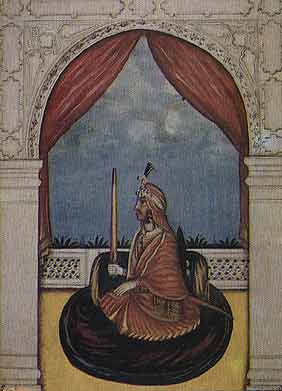
Nau
Nihal Singh, the son of Maharaja Kharak Singh was a handsome, vicious and ambitious
youth, who was entirely guided by the crafty Minister Raja Dhian Singh.
On
the deposition and imprisonment of his father, Nau Nihal Singh was proclaimed
Maharaja.
Nau Nihal Singh seldom saw his imprisoned father, but when he did
so, it was only to threaten and abuse him.
When his father's death was announced
to him, instead of being affected by it, he seemed to think that now the day of
his rejoicing and happiness had arrived and calmly gave orders for the cremation
of his father's corpse.
This ceremony was performed in an open space opposite
the mausoleum of Ranjit Singh. On its completion Nau Nihal Singh, taking the hand
of Mian Uttam Singh, son of Raja Gulab Singh and nephew of the Minister Raja Dhian
Singh, started at the head of the returning funeral procession to proceed through
a deep arched gateway.
As they were emerging from the gateway, a crash was
heard: beams, stones and tiles fell from above, and the two young men were struck
to the ground.
Mian Uttam Singh was killed on the spot, but the young Maharaja
was picked up senseless, placed on a litter and conveyed to an apartment in the
adjacent Lahore Fort by Dhian Singh, who allowed no one to see or attend upon
him except himself and two of his immediate followers. Then it was that the infamous
Dhian Singh had him smothered: at least the Sikhs and others came to think so.
At
first it was given out to the Sikh Sardars, that Nau Nihal Singh was likely to
do well, was only wounded and for a time insensible.
Shortly afterwards Dhian
Singh visited Nau Nihal Singh's mother, and told her that her son had died about
half an hour after his removal to the Fort.
Dhian Singh then convened an Assembly
of some of the principal Sikh chiefs and told them the same story, and advised
that the Maharaja's death should not be made public fora few days, when it should
be decided whether Nau Nihal Singh's mother Maharani Chand Kaur, or Prince Sher
Singh, a reputed son of Ranjit Singh, should be selected to rule.
Dhian Singh
had promised Chand Kaur during his interview with her that she should reign, but
his great object was to ensure her silence and gain time, until the arrival of
Sher Singh to whom he had privately written to lose no time in coming to Lahore.
On
Sher Singh's arrival the death of Maharaja Nau Nihal Singh was publicly made known,
and after much intriguing and some very severe fighting Raja Gulab Singh, who
was supporting Chand Kaur's claim and maintaining the Citadel of Lahore against
the Sikh army, surrendered the Citadel to Sher Singh, who became the Maharaja
of Panjab.
COMMENTS
As
observed in Maharaja Kharak Singh- during the period from de facto deposition
of Kharak Singh to his death, Nau Nihal Singh may be more correctly designated
as a self-appointed Regent rather than a full-fledged Maharaja.
The real name
of Gulab Singh's son who was mortally struck under impact of crashed masonry was
Udham Singh.
MAHARAJA SHER SINGH
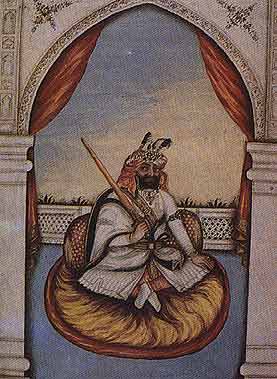
Within
eighteen hours of murderous assaults on Maharaja Sher Singh. his twelve-year-old
son Partap Singh and Vizier Dhian Singh, the Sikh soldiery killed the killers.
When
Maharani Mahtab Kaur had been married to Ranjit Singh for more than ten years
without bearing him any children, it was given out soon after Ranjit Singh's departure
from Lahore on his cis-Satluj campaign of 1807 that the Maharani was pregnant.
On
the Maharaja's return, his wife presented him with Sher Singh and Tara Singh as
her twin sons.
But Ranjit Singh was not deceived: he knew his wife was barren
and had bought the children to pass them off as his own, and had once before for
the same purpose purchased one which had died. It, however, suited him to acknowledge
these children as his own, and they were always treated as his sons and bore the
title of Shahzada (meaning) Prince.
Sher Singh succeeded Nau Nihal Singh in
1841.
Sher Singh was a brave but stupid man, had seen much service with the
Sikh army and was popular with the soldiers, with whose aid he was subsequently
able to establish himself on the Sikh throne, after compelling Raja Gulab Singh
to surrender the Citadel o Lahore.
Shortly after the succession of Sher Singh
intrigues and a most mutinous spirit became rampant in the Sikh army, and the
Maharaja and his Government soon lost all control over it.
The military administration
was conducted by Panchayats of Councils of five delegates per Regiment elected
by their comrades, who demanded increase of pay, dismissal of all officers obnoxious
to them etc. On their demands being refused they murdered many officers, and plundered
Lahore. At last, tired of their own excesses, they modified their requests and
tranquillity was restored, but discipline and subordination in the army had entirely
ceased.
Maharaja Sher Singh, on all occasions, expressed himself favourable
to the British, scrupulously adhering to Ranjit Singh's policy regarding them.
It was solely owing to him, that the British army, returning from Afghanistan
in 1842, was allowed undisputed passage through Panjab, though many of the Sikh
chiefs were anxious to attack it, as they thought that the potent spell of victory,
so long attached to the British arms had been broken at Kabul, and by the policy
of evacuating Afghanistan.
About two years after Sher Singh's accession, he
was assassinated on 15 September 1843 by the Sandhanwalia Sardars Ajit Singh and
his Uncle Lehna Singh.
Immediately after the completion of the foul murder,
they with their followers proceeded towards Lahore three miles distant.
On
their way they met Raja Dhian Singh, who had instigated them to kill Sher Singh.
They, having killed the Maharaja, insisted on Raja's going back to his house (and
pretended that there) they wished to tell him (in detail) what had occurred, and
(that there they wanted) to consult him as to what steps should now be taken (to
consolidate gains to mutual advantage).
As the Sandhanwalia Sardars and their
followers far outnumbered the few men with Dhian Singh, he was forced to comply,
but no sooner had they dismounted at his house and gone inside with him than they
murdered him and some of his followers.
Dhian Singh's son Raja Hira Singh,
having escaped when his father was killed, rode at once to the large Sikh (army)
camp in the neighbourhood of Lahore, made a stirring speech to the soldiers, telling
them of the murders of their Maharaja, and of his father Dhian Singh by the Sandhanwalia
Sardars Ajit Singh and Lehna Singh, whom he declared traitors (to the Lahore Durbar)
and friends
of the British. He also said that their pay would be increased,
and that he would moreover reward them with largesse from his own and his father's
funds.
The soldiery at once responded to Hira Singh's speech, marched on Lahore
Fort, stormed and took it that evening, killing Sardars Ajit Singh and Lehna Singh
and exterminating their followers. Thus within eighteen hours these men met the
just punishment for crimes they had committed that day.
COMMENTS
Sher
Singh's service with Sikh army alluded to by Sir John W. McQueen included his
occupation of Jahangiria Fort, dislodging the Barakzai half-brothers Dost Muhammad
Khan and Jabbar Khan from their entrenched positions near that fort, inflicting
severe defeat on the Muslim fanatic Sayyad Ahmad Barelvi in 1829, snatching from
him Peshawar and exhorting the Sikh army to despatch him in the jaws of death
in the engagement fought in May 1831 at Balakot in Hazara area.
The British
diplomat Alexander Burnes was murdered in Kabul on 2nd November 1841.
After
that event, Dost Muhammad Khan's son Akbar Khan slaughtered Governor-General Lord
Auckland's Political Adviser Sir William Macnaghten while both were in conference.
The Treaty of Evacuation was signed on 2nd January 1842. Four days later, British
soldiery 16,000 strong budged away from the camping grounds. Out of them Dr. Brydon
alone reached Jalalabad to narrate the vicissitudes of the journey. Subsequent
events included Shah Shuja's murder by his nephew in April 1842, Akbar Khans'
reverses in two battles with General Pollock, the fall of Ghazni, the British
capture of Kabul on 16th September 1842, the British bombardment of Kabul Bazar
as the only resort to conceal British plight, evacuation of Kabul on 12th October
1842 and retirement of British army via Khyber Pass.
In his poetic work Vijay
Vinod in mixed Hindi-Panjabi-Urdu authored in 1844 and published by Shiromani
Gurdwara
Prabandhak Committee, Amritsar in 1950 as part of Prachin Jangname,
ed. Shamsher Singh Ashok, Gwal reports that in the Baradari (near) Shah Bilawal,
(three miles from suburbs of Lahore), Sardar Ajit Singh Sandhanwalia told Maharaja
Sher Singh that he had secured a London-made double-barrelled firearm. When Maharaja
Sher Singh advanced his hand to receive the weapon, Ajit Singh Sandhanwalia pressed
its trigger while his soldier standing behind him beheaded the Maharaja. To the
foregoing Gwal's version Pandit Debi Prasad adds in his Urdu work Tarikh-i-Panjab,
Bareli, 1850 that Ajit Singh laughed while in loud voice he told Maharaja Sher
Singh ensconced in chair reclining on cushion: "This double-barrelled (rifle)
has been purchased for fourteen hundred (rupees), but I shall sell it not even
for three thousand (rupees)."
In the meanwhile, (in the nearby Tej Singh's
Garden), Lehna Singh Sandhanwalia killed (Maharaja Sher Singh's twelve-year-old
son) Prince Partap Singh.
Gwal, op cit., records that Ajit Singh Sandhanwalia
endeavoured to descend from the fort but the rope held by him snapped. While he
fell on ground, the sepoys rushed on him and chopped his head. Gwal further reports
that the trunks of the dead Lehna Singh and Ajit Singh were hung in Lahore respectively
on Masti Gate and Dilli Gate.
MAHARAJA DALIP SINGH
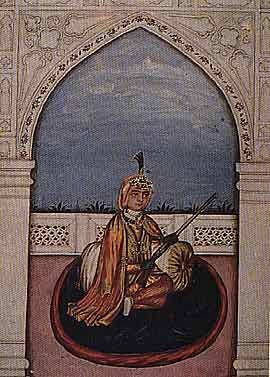
He was without any force of character, vain and weak, liked society and being noticed and made much of, entertained largely and was famous for his shooting parties.
After
the Satluj Campaign, when the British army reached Lahore in March 1846, Dalip
Singh, a child of nine years, was the titular Maharaja of the Panjab, and as it
was convenient to accept the status quo and a Ruler being required for the country,
which the British Government had then no desire to annex or permanently occupy,
the reputed child of Maharani Jindan and the water-carrier Gullu was confirmed
on the throne of the Lion of Panjab.
Fortune, with her ever turning wheel,
must have laughed at the transformation.
After the general outbreak of the
Sikhs in 1848 all over the Panjab, which led to Second Sikh War, Dalip Singh was
deposed on 29th March 1849, and sent to Fatehgarh in Hindustan, and subsequently
in 1851 to England.
Dalip Singh was well educated, and brought up as an English
gentleman, moved in the best society in town and country, was provided with a
large, fine Estate, and Mansion in Norfolk, and had a liberal income granted him
by the Government of India.'
Dalip Singh was without any force of character,
vain and weak, liked society and being no'iced and made much of, entertained largely
and was famous for his shooting parties. He interested himself in his Norfolk
Estate, and was very particular in preserving game. Also Dalip Singh rented for
many years some excellent grouse moors in Scotland. He was a most keen sportsman
and a first class shot.
Dalip Singh was very extravagant, and though the Government
of India once came to his assistance, he thought it would continue to do so, and
so made no attempt towards reducing his expenditure.
In 1861, Dalip Singh went
to India for a few months with the hope that his presence in that country might
move Government to give him a large income or a lumpsum to pay his debts, but
this plan had no immediate result.
In 1864 Dalip Singh married an Abyssinian
lady by whom he had a son Prince Victor Dalip Singh, who on his father's death,
succeeded to what was left of Maharaja Dalip Singh's property, but not to his
title.
Maharaja Dalip Singh died in 1890.
COMMENTS
In
his Panjabi work Mahan Kosh, Bhai Kahan Singh writes that Maharaja Dalip Singh
was born in February 1837, but he points out that some writers give the Maharaja's
date of birth as 4th September 1838. The author of the Parties and Politics at
the Sikh Court: 1799-1849, reports on page 127 of that work that Dalip Singh was
born in 1838. The author of The Khalsa Raj, New Delhi, 1985 observes on pages
183 and 184 of that work that following the murders of Maharaja Sher Singh and
his son Partap Singh on 15th September 1843, the five-year-old son of the late
Maharaja Ranjit Singh was raised to the throne.Thus Dalip Singh was five years
old in September 1843 whence we conclude that he was born in September 1838.
Maharaja
Dalip Singh's journey to Fatehgarh in present Uttar Pardesh in India commenced
in April 1849. He sailed for England on 19th April 1854.
Based on the information
supplied by Dalip Singh himself, an Editorial of Moscow Gazette published in September
1887 revealed that Dalip Singh was treacherously deprived of his Kingdom and was
not permitted to receive education at Cambridge or Oxford lest his innate genius
should develop and grow.
Dalip Singh's Abyssinian wife Bamba Muller bore him
three sons Victor Dalip Singh, Frederick Dalip Singh and Albert Edward Dalip Singh,
respectively born in 1866,1868 and 1879. The couple had three daughters Bamba
Jindan, Katherine and Sophia Alexandra born respectively, in 1869, 1871 and 1874.
Bamba Muller passed away on 18th September 1887. On 21st May 1889, in Paris, Dalip
Singh married A. D. Wetherill. Dalip Singh's children died issueless.
Maharaja
Dalip Singh died as a paralytic patient like his real or supposed father Ranjit
Singh. On 22nd 1893, in his apartment in Grand Hotel in Paris he encountered death
while lost in slumber. His dead body was removed to England to be buried in the
church graveyard in his estate in Suffolk. There he rests in the grave while the
Sikh simpletons continue visiting it and calling it Samadh. Grave is translatable
in Panjabi as Qabar, not as Samadh. Samadh is a monument erected in memory of
a deceased Hindu or Sikh saint, warrior, martyr or potentate.
RAJA GULAB SINGH
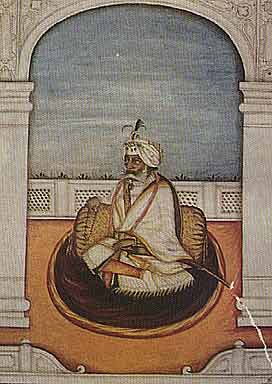
There are perhaps no characters in Panjab History more repulsive than Rajas Gulab Singh and Dhian Singh: their splendid talents and undoubted bravery only rendered more conspicuous their immorality, atrocious cruelty, treachery, avarice and unscrupulous ambition.
Sometime previous to his death,
Ranjit Singh had taken into special favour his Prime Minister Dhian Singh's family
consisting of his two brothers Gulab Singh and Suchet Singh and his son Hira Singh,
upon all of whom he conferred the title of Raja with princely fiefs for their
maintenance.
The three Dogra brothers, poor but of good family, entered the
Sikh service as troopers.
Handsome and well educated, they soon attracted (Maharaja's)attention
by their ability, determination and bravery, and rapidly rose to high positions,
where their influence in public affairs became paramount, but not being Sikhs,
they were looked on with jealousy by the (Sikh) chiefs.
They played deeply
in the intriguing game of that time, being it on gaining power, wealth and independence.
There are perhaps no characters in Panjab History more repulsive than Rajas Gulab
Singh and Dhian Singh: their splendid its and undoubted bravery only rendered
more conspicuous their immorality, atrocious cruelty, treachery, avarice and unscrupulous
ambition.
"The eldest of the brothers Raja Gulab Singh was generally
employed on military duties, and it was he who commanded the Dogra troops in the
defence of the Citadel of Lahore (when Sher Singh entered Lahore on 14th January
1841 in a bid to Lahore Fort from Gulab Singh).
Raja Gulab Singh held the Citadel
with some two thousand and ten guns, and some twelve hundred Sikh Infantry: the
latter could not, however, be trusted, but he kept them overawed in the places
they occupied in the Fort with four loaded guns pointed at them and four hundred
Dogra Infantry in advantageous positions overlooking them.
Prince Sher Singh
advanced to take the Fort with all (available) troops in the neighbourhood of
Lahore, numbering some fifty thousand and (carrying varied) arms. They marched
during night, occupied the city, and as day dawned, entirely surrounded the Fort
with a deep line of densely wedged men brought close up to the (Fort) walls.
Sher
Singh's guns were so numerous that they formed one connected battery round the
Fort. Twelve guns were placed opposite Western Gate (of Fort) and six opposite
its Eastern Gate.
Calmly and silently the besieged viewed these formidable
preparations for the assault.
Suddenly the entire circle of guns, some two
hundred in number, opened fire of blank cartridges in expectation of terrifying
the defenders.
At length the firing ceased, and the guns opposite the (aforesaid)
two (Fort) Gates fired a crashing ilium of a bull with canister of grape placed
over the beast, which utterly destroyed the Gates, and the Sikh columns headed
by fanatical Akalis dashed forward for assault.
Gulab Singh had howitzers placed,
close to the Gates and commanding them and the inward ascent from them, four guns
heavily charged with grape, which were fired into the dense crowd of assailants,
killing great numbers and driving back the rest.
This success at both Gates,
and the promptitude with which the Dogras lining the (Fort) walls without waiting
for orders poured a rapid fire of musketry upon the confused masses below, soon
clearing the besiegers from their proximity to the (Fort) walls and Gates:
they
had to retire to a more respectable distance, deserting many of their guns.
For
five days the Sikh troops (outside the Fort) maintained heavy fire, making several
breaches, but not daring an assault.
On fifth day Raja Dhian Singh with some
Dogra troops arrived at Shahdara on the opposite side of Ravi some three miles
from the Fort.
Prince Sher Singh went to Dhian Singh and begged him to arrange
matters between him and Gulab Singh so that the latter should surrender the fort.
This was done, and the Dogras marched out with all honours of war, taking with
them their entire property as well as much treasure.
After the murder of Sher
Singh and that of Raja Dhian Singh by the Sandhanwalia Sardars, Gulab Singh became
for a time the most important person in Lahore State, and his services to the
British during the Satluj Campaign were such that he was granted the independent
sovereignty of the Province of Kashmir on the payment of a million sterling.
Gulab
Singh ruled Kashmir for many years with an iron hand
In 1857 during the crisis
of Indian Mutiny Gulab Singh aided the British Government with a strong Contingent
of his troops.
Gulab Singh died (in August 1857).
COMMENTS
In
1818 Dhian Singh replaced Jamadar Khushal Singh as Chamberlain and was created
Raja. In 1822 Gulab Singh and Hira Singh were created Rajas. In 1828 Dhian Singh
received the title of Raja-i-Rajgan and was raised as Prime Minister.
According
to a manuscript in Hindustani preserved in the British Library in London vide
Accession Number Or. 1733 Raja Dhian Singh, Raja Gulab Singh, Raja Suchet Singh
and Raja Hira Singh were, respectively, granted Jammu, Akhnur, Ram Nagar and Jasrota
as fiefs.
Dhian Singh and Gulab Singh entered Ranjit Singh's service as troopers
in 1811. Two years later they summoned Suchet Singh for joining them at Lahore.
In
enumerating the virtues and vices of Gulab Singh, Sir John W. McQueen literally
repeats the version preserved in H. Lepel Griffin's work Ranjit Singh except that
he adds the word immorality in the list.
Griffin and McQueen do not lie when
they describe Gulab Singh as avaricious. In July 1840 Maharaja Kharak Singh rebuked
Gulab Singh for his removal to Jammu the property and money from Minawar Fort
and other forts in Minawar region.
We may present as an instance of Gulab Singh's
military prowess his valorous participation in the siege of Multan in 1818, which
elicited applause of Maharaja Ranjit Singh.
Governor-General Lord Dalhousie's
letter dated 18th February 1849 to Sir Henry Lawrence referred to in Bhai Kahan
Singh Nabha's Panjabi work Mahan Kosh contains following comment on Gulab Singh's
conduct:
... regarding Goolab Singh, you disclaim
being his admirer, and urge your desire to make the best of a crooked character,
I give you the fullest credit for both assurances.
In
his work Life of Lord John Lawrence, R. Bosworth Smith refers to Gulab Singh as
an unscrupulous villain (who secured Kashmir by paying to the British Indian Government)
down at once in the hard cash) which he had stolen from the Lahore Durbar.
Gulab Singh actually ruled Kashmir for less than eleven years. Under unofficial
secret instructions of the Prime Minister of Lahore Misar Lal Singh, the Governor
of Kashmir Imad-ud-Din delayed delivery of possession of Kashmir to Gulab Singh
who sough British help to coerce Imad-ud-Din to quit Kashmir valley. At long last
on 23rd October 1846 Imad-ud-Din moved out of the capital of Kashmir. Gulab Singh
entered the capital of valley as de facto ruler of Kashmir on the 9th November
1846 at the hour recommended by the astrologers as auspicious. Kashmir had been
transferred to Gulab Singh by provisions of the Treaty concluded at Amritsar on
the 16th March 1846. A gap of eight months spanned between Gulab Singh's de jure
title to Kashmir and its de facto control by him.
Gulab Singh undertook to
send two thousand soldiers as aid to his erstwhile British benefactors, but before
they departed, death gripped him. His successor fulfilled the promise earlier
made by Gulab Singh.
RAJA DHIAN SINGH
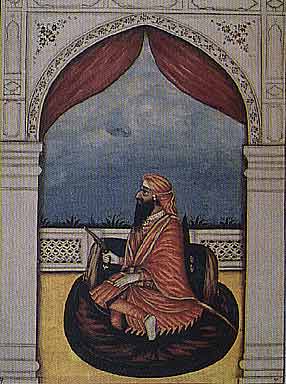
Raja
Dhian Singh, the second brother, was, during Ranjit Singh's life and until he
was murdered in 1843, the most conspicuous and powerful of the three Dogra brothers,
and was virtually Prime Minister for some time.
When the deposed Maharaja Kharak
Singh died, not without suspicion of poisoning, and his son Nau Nihal Singh met
his death by what was called an accident, the designing Prime Minister supported
the Queen Mother Chand Kaur in her claim to govern on the ground that her deceased
son's widow was enceinte. Also at the same time he inspired Prince Sher Singh
to advance his claim to the throne, as a son acknowledged by Ranjit Singh.
An
armed contest commenced between the two claimants.
The Prince appealed to the
army, secured its aid by lavish promises, and made a dash at the Capital, when
Queen Mother with a Dogra force under Raja Gulab Singh retired into Lahore Citadel
and stoutly defended it for five days, during which time some thousands were killed
and the City of Lahore plundered.
The clever Dogras, while apparently taking
opposite sides, but actually (and secretly) working in unison, actively participated
on both sides and secured much wealth.
Maharaja Sher Singh confirmed Dhian
Singh in his appointment of Prime Minister.
Though Sher Singh never trusted
Dhian Singh but fear could not govern the Panjab without Dhian Singh's help and
guidance.
On the day when Sher Singh and Dhian Singh were assassinated by the
Sindhanwalia Sardars Ajit Singh and Lehna Singh and their followers, Dhian Singh's
son Raja Hira Singh appealed to the Sikh army to avenge their deaths: this was
carried out at once by attacking and exterminating the Sandhanwalias in Lahore
Fort.
The young Raja Hira Singh brought the head of his father's murderer
to the widow, a noble Rajputni dame, who was waiting by her husband's body. Placing
his father's warrior plume on the son's turban, she said: "My mind is now
at perfect peace. Let the funeral be prepared, and I will follow my Lord in his
journey to the next world. When I see your father, I will tell him that you acted
as a brave and dutiful son".1
COMMENTS
Dhian
Singh held position of Prime Minister for fifteen years from 1828 to his death
in 1843.
Sir John
W. McQueen rightly dubs Dhian Singh as the Prime Minister. When Dhian Singh received
from Jamraud Hari Singh Nalwa's message asking for reinforcement for fighting
to a finish the engagement with the Afghans, he did not immediately confide the
matter to Ranjit Singh. Nalwa fell dead on 30th April 1837. Timely despatch of
reinforcement to Jamraud would have perhaps forestalled death of Nalwa. But Dhian
Singh was jealous of Nalwa and wanted quick terminus to the life of that brave
General. Dhian Singh's role in the matter elicited utmost wrath of Maharaja Ranjit
Singh.
We learn from the Hindustani manuscript preserved in the British Library
in London vide Accession Number Or. 1733 that Dhian Singh seized gold and silver
from Lama Guru and drove him to China. The same document further reveals that
Dhian Singh snatched silver from the domes and terraces of Thakurdwaras.
We
further learn from the aforesaid document that the Minawar Fort near Jammu contained
a big treasure. Whenever Maharaja Ranjit Singh encamped near Jammu, he expressed
a desire to
see Minawar Fort. Dhian Singh apparently appreciated the idea but
later he would find some excuse to take the Maharaja elsewhere.
Comparisons
are odious! While Maharaja Ranjit Singh enriched
holy
places, his Vizier Dhian Singh looted them.
RAJA SUCHET SINGH
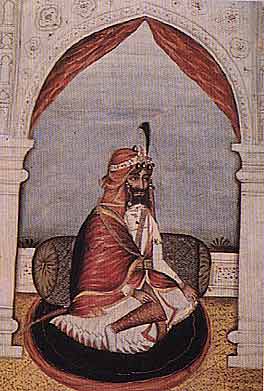
Suchet
Singh, the third brother of the Jammu Dogra family, was the handsomest man in
the Sikh army and a splendid figure at Court, where he was remarkable for his
debaucheries.
Suchet Singh had been a special favourite of Ranjit Singh and
had free access to the royal zenana, and fully availed himself of the opportunities
to carry on intrigues with some of its fair inmates, more (particularly), it is
said, latterly with Maharani Jindan.
Suchet Singh had little of ability of
his brothers Gulab Singh and Dhian Singh, and played altogether quite a subordinate
part in lahore politics.
He was an exceedingly brave and dashy soldier and
a sabreur noted for his horsemanship and skill at arms.
(Following Dhian Singh's
murder on 15th September 1843,) Suchet Singh's nephew Raja Hira Singh was (raised
as) Prime Minister to Maharani Jindan who thenceforward acted as Queen Mother
and Co-) Regent (with her brother Jawahar Singh) for her son Dalip Singh.
Suchet
Singh was a lover of Maharani Jindan, who on her part turned his affection and
bade him aspire to Wazarat (or Viziership) which she promised to bestow on him
should he succeed in having Prime Minister Hira Singh deposed. Jindan (on her
part) disliked Hira Singh on account of his strong control in State matters.
When
Sher Singh and Dhian Singh were murdered (on 15th September 1843), Raja Gulab
Singh was not at Lahore. He went there some months afterwards in order to carry
with him to Jammu a large quantity of money, jewels and other property he had
at Lahore and also to consult and to come to an understanding with his nephew
Raja Hira Singh as to how State and other matters were to be managed by them to
their mutual advantage.
Raja Gulab Singh persuaded his brother Suchet Singh,
over whom he had great influence, to return with him (from Lahore) to Jammu, and
after a time further persuaded him that as he had no son, he should adopt a son
of his as heir to his Estate and wealth. Suchet Singh adopted Gulab Singh's third
son as his heir.
Shortly after this the Sikh troops at Lahore demanded an increase
of pay etceteras and on the Prime Minister's rejecting their demands surrounded
his house with clamorous mobs and on the third day threatened him with deposition
or death, unless he complied.
In the meanwhile news of this and also a request
from Sikh Regiments to Suchet Singh to come to them quickly reached Jammu. This
(solicitation) he hastened to avail himself of, as he perceived (therein) an opportunity
it would give him to win over with lavish promises all Sikh troops, and with their
aid to depose Hira Singh.
Suchet Singh therefore without delay started for
Lahore with such troops as he had with him at Jammu.
He arrived at a ferry
on the Ravi seven miles from Lahore on the evening of the day when Hira Singh
had won over the Sikh troops by giving in to their demands.
Leaving the main
portion of his troops on the north bank, Suchet Singh crossed over to the south
bank with some three hundred and fifty men, and occupied (an old Mosque) and ground
near it not far from the ferry.
Suchet Singh had hardly done so, when messengers
from the four Regiments, which had invited him to come to Lahore arrived and told
him what had happened, and advised him to return at once to Jammu, as it was now
impossible for them to help him in any way.
He later heard from his nephew,
the Prime Minister, that he was marching upon him with the Khalsa army and threatened
him with destruction, unless he went back at once to Jammu.
But the Dogra,
rash as he was brave, remained on quietly in the old Mosque where he was resting,
but his party of about three hundred and fifty men, who had crossed the river
with him, rapidly dwindled to forty-six before morning, when they were surrounded
by some ten thousand Sikh troops under Hira Singh with fifty-six pieces of Artillery,
which opened fire on the Mosque and after a little time all of the Sikh troops
advanced en masse to (launch) attack.
When they had approached to within a
hundred yards (from Mosque), Suchet Singh and his handful of heroes, swords in
hands, rushed upon a thick mass of their enemies, and so fierce and desperate
was their assault, that they actually broke through and drove back a great number.
But
their desperate valour availed not the devoted band so fearfully overmatched!
Raja
Suchet Singh and forty-two of the brave band were lying dead on the field: four
fell badly wounded, of whom only one survived.
Thus fell the gallant Suchet
Singh and his staunch band of Dogras, performing prodigies of valour: the names
and deeds of some are still famous in the Sikh Story as well as Dogra Story.
The
total loss of the attacking Khalsa force is said to be about one hundred and sixty
killed and wounded.
When the handsome Raja Suchet Singh was killed at Lahore,
his ten wives and some three hundred unmarried ladies of his zenana committed
Sati, some at Lahore, some at Ram Nagar where his head was brought and others
at Jammu or at their homes.
COMMENTS
Gulab
Singh reached Lahore on 10th November 1843. Hira Singh hated his uncle Suchet
Singh because the latter had soft corner for the holy man Baba Bir Singh of Naurangabad
who had a quite enormous following among Sikhs. Suchet Singh respected Baba Bir
Singh while Hira Singh discerned in the latter a potential danger to his pelf.
Gulab Singh utilised his visit to Lahore for rapprochement between Hira Singh
and Suchet Singh for ensuring Dogra Group's unity, which was being eroded constantly
by the sinister advice to Hira Singh by his wily and crooked Mashir-i-khas, or
Special Counsellor named Jalla. Having failed to retract the uncle and nephew
from their pernicious course, Gulab Singh chose the other alternative of keeping
the two recalcitrants at a distance. He advised Suchet Singh to accompany him
to Jammu. On 4th December 1843 Gulab Singh and Suchet Singh left Lahore for Jammu.
On
arrival at Jammu, Gulab Singh prevailed upon Suchet Singh to adopt the former's
son Ranbir Singh. Suchet Singh did the needful.
Among the wounded persons who
gasped on the battlefield lay Suchet Singh's Counsellor Rai Kesari Singh who asked
for water. A sardonic smile played on the latter's lips when Hira Singh told him
that rather than marching down to plain he should have preferred stay in the mountains
where there is no dearth of cold potable water. Perhaps a drop of water would
have lengthened Rai Kesari Singh's lease of life. However, the practice of denying
water to one's son going to battle against odds, and pouring water into the mouths
of the foes wounded on the field, dating back to the days of Guru Gobind Singh,
elicited no appreciation from the hard vetch named Hira Singh. Rai Kesari Singh
had already slain twenty enemies when he sustained serious wound and fell aground.
The battle took place on 27th March 1844
RAJA CHATAR SINGH ATARIWALA
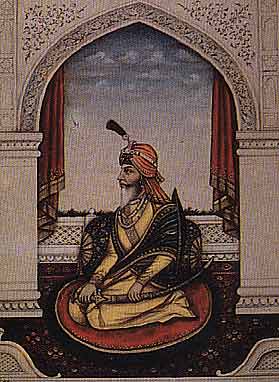
Sardar
Chatar Singh was the head of the younger branch of the Atari family, who (towered
over) Sidhu Jats, the best blood of the Majha. He took no share in politics during
the reign of Ranjit Singh, but his family possessed great influence at Court,
and in 1843 his daughter Tej Kaur was betrothed to Maharaja Dalip Singh.
In
1846 he was appointed to succeed his son Sardar Sher Singh as Governor of Peshawar,
but his rule was no purer than that of his son. The corrupt politics, that both
indulged in, astonished even the Lahore officials, but the family was too powerful
to be lightly offended, and too nearly connected with Maharaja (Dalip Singh) to
be passed over.
Chatar Singh was transferred from Peshawar to the Governorship
(of the region) between the Indus and Jehlam Rivers and Sher Singh was received
in the Lahore State Council and a little later got the title of Raja. This honour
had been recommended for bestowal on Sardar Chatar Singh, but at the last moment
he requested that instead his son be given it, and his wish was granted.
When
Multan Outbreak occurred in April 1848, Chatar Singh Was in Hazara. His troops
were notoriously disaffected towards lahore Government: this disaffection he shared
and encouraged. At first Chatar Singh had only two thousand men, but he rapidly
increased their number, and sent them to his son Sher Singh for his aid and also
to Maharaja Gulab Singh of Jammu, and encouraging him in his actions, also to
Amir Dost Muhammad Khan.
Chatar Singh raised levies in Peshawar and in his
own districts, and used all means in his power to make his rebellion as formidable
as possible. After taking Attock Fort on 2nd January 1849, Chatar Singh marched
from Hazara with a considerable force to join his son's army, which he did (on
16th January 1849) three days after the Battle of Chillianwala.
On 21st February
1849 was fought the decisive, and for the British the brilliant and memorable
Battle of Gujrat with the united Sikh and Afghan army of some sixty thousand men,
which was completely defeated by Lord Gough with the heavy loss of men and fifty-three
guns. This was virtually the end of Panjab Campaign. The victory was followed
up with vigour, and at Rawalpindi, on the 14th March 1849, Chatar Singh and Sher
Singh with what remained of Sikh army, some sixteen thousand men, laid down their
arms.
After this, Sardar Chatar Singh and Raja Sher Singh were sent as prisoners,
first to Allahabad (Fort) and then to Calcutta. Their Estates were confiscated,
but they were granted fitting allowances.
In January 1854, they were released
from confinement and allowed to choose their places of residence within certain
limits. Also their allowances were considerably increased. Chatar Singh chose
to remain in Calcutta where he died early in 1858.
COMMENTS
The plain territory between Rivers Bias and Ravi is known as Majha.
The British
authorities did not let the betrothal mature into marriage. At long last Tej Kaur
was got married to Janmeja Singh Gill of Mariwala. She gave birth to two sons.
In Allahabad Fort, Chatar Singh and Sher Singh were not permitted to sleep
outside their cells. They perspired while they slumbered during nights
Actually
Chatar Singh died in Calcutta on 18th January 1856.
RAJA SHER SINGH ATARIWALA
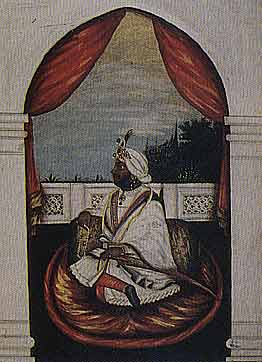
He
was an able and spirited man who ruled that difficult district to the satisfaction
of Lahore Government.
Sher Singh Atariwala was Sardar Chatar Singh Atariwala's
eldest son.
In 1844 Sardar Sher Singh was appointed Governor of Peshawar.
He
was an able and spirited man who ruled that difficult district to the satisfaction
of Lahore Government.
Sher Singh Atariwala successfully put down a Yusafzai
insurrection, but his administration though vigorous was usually corrupt. He was
moved to Lahore and made a Member of the State Council and shortly afterwards
given the title of Raja.
In April 1848 occurred the Multan Outbreak and Diwan
Mul Raj stood forth as a rebel against the Lahore Government. Sher Singh was sent
to Multan with a Sikh force, which joined Lt. (Herbert) Edwardes near Multan Fort
on 6th July. Although the Sikh army was disposed to mutiny, Sher Singh had sufficient
influence over it to keep it tolerably under control, and on 20th July (1848)
it co-operated with Edwardes' force with energy and success.
On 18th August
(1848), General Whish, with a British force, reached the neighbourhood of Multan
and was joined by the troops under Edwardes and Sher Singh Atariwala.
On the
following day news was received of the rebellion of Sardar Chatar Singh and his
army in Hazara. Although Sher Singh constantly received letters from his father
to join him, he and some of his Sardars did their utmost to suppress the spirit
of mutiny among their men, and even got them to take part in the operations before
fall of Multan.
However, on 14th September (1848), Sher Singh's whole camp
rose in mutiny. His and his Sardars' lives were threatened, and at last in desperation,
he went over to the side of rebels and marched with his force to Multan, when
he had to camp outside the walls of the Fort and City. Mul Raj distrusted him,
and refused him admittance into either.
This defection of Sher Singh's large
force compelled General Whish to raise the siege of Multan for a time, until reinforcements
in men and siege guns should reach him.
Finding Mul Raj distrusting him, Sher
Singh decided enjoining his father at Hazara. Mul Raj, to hasten his departure,
advanced him a considerable sum of money, and Sher Singh with some five thousand
men marched from Multan.
On 22nd November (1848), Sher Singh's force received
a check at Ramnagar from the British army under Lord Gough.
On 3rd December
(1848), Sir Joseph Thackwell attacked Sher Singh's position at Sadullapur. The
action was indecisive, but on the night of 3rd December Sher Singh retreated towards
the Jehlam, and took up a position at Chillianwala, where on the 13th January
1849 the British army under Lord Gough attacked him. The account of this battle,
little creditable to the British, has often been written. It has been called a
victory (by Sikhs), but neither the (British) Generals nor their soldiery ever
considered they had been defeated. Both sides fought well, but the hero of the
day was Jawahar Singh, the son of the famous Sikh General Hari Singh Nalwa, who
led the Sikh cavalry charge that had so great influence on the result of the battle.
Six
weeks later on 21st February 1949 Sher Singh aided by hiS father's and Dost Muhammad's
forces fought the Battle of Gujrat. His army was decisively routed with heavy
losses in men, guns and material. This was their last battle of the war, for a
few days later the whole Sikh army gave up their arms at Rawalpindi and dispersed
to their homes.
After that Sher Singh was placed under surveillance at his
home but being discovered plotting treason was sent a prisoner (to Allahabad Fort
and later) to Calcutta. His property was confiscated, but he was granted an allowance.
In
January 1854, Sher Singh's conduct having been irreproachable since the annexation
of the Panjab, he was released.
Sher Singh volunteered his services in Burmese,
Persian and Southall campaigns, but they were not accepted.
At the outbreak
of the great Indian Mutiny, Sher Singh Atariwala supported the British authorities
as far as it lay in his power and sheltered in his house several British residents
of the place.
Raja Sher Singh Atariwala died in exile in 1858 far from his
own country at the sacred city of Banaras by waters of the Holy Ganges.
COMMENTS
Chatar
Singh had five sons and one daughter.
Sher Singh passed away on 7th May 1858.
RAJA TEJ SINGH
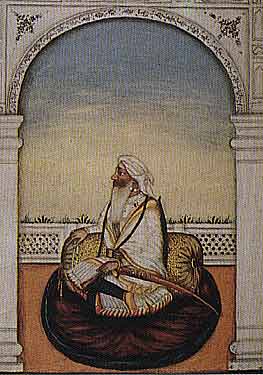
Tej
Singh was the son of a Brahman of Meerut District, and was brought to the notice
of Ranjit Singh by his uncle Jamadar Khushal Singh, the Chamberlain.
The uncle
and nephew became Sikhs, and in 1819 Tej Singh, who was a soldier, was promoted
to the rank of General.
Tej Singh saw much service in Kashmir, Punchh, Dera
Ismail Khan, with Maharaja Ranjit Singh at the famous battle at Tehri in Yusafzai
(tract), and in a number of fights on the Peshawar border under General Budh Singh,
and later on in Hazara.
He was Governor of Peshawar, when the Prime Minister
Raja Lal Singh summoned him to Lahore in October 1845, when the war against the
British was declared and he was appointed Commander-in-Chief of the Khalsa army.
On
15th December 1845 Tej Singh joined his Division of the army, and when Raja Lal
Singh was defeated at Mudki and afterwards at Firozshah, on 22nd December, Tej
Singh advanced against the British army, which was completely exhausted and almost
without ammunition. He drove in the British Cavalry parties, failed in the half-hearted
attack made at Firozshah and on the British force advancing, he retired from the
field, and crossed to Sabraon on the Satluj twenty-five miles north-east of Firozpur,
where he joined Lal Singh's defeated army. The united Sikh armies made great entrenchment
on the south of the river, and spent six weeks strengthening their position with
all their forces and guns.
On the 1Oth of February 1846 was
fought the Battle of Sabraon but Tej Singh had so little to do with it that a
description of it would be out of place.
After the British annexation of Lahore,
Tej Singh was summoned to that city and confirmed in his appointment of Commander-in-Chief,
and to him and Lal Singh, now Vizier, were entrusted the new arrangements about
the army.
The conduct of Sardar Tej Singh, both before and after the Satluj
Campaign, has been misrepresented.
In the first place the Sardar was averse
to the war and delayed as long as he could in joining the army, which conduct
may prove (his) cowardice or disinclination for war, but which ultimately did
not savour of treachery.
But it has been said that Tej Singh's conduct at Firozshah
was inconsistent with any other supposition than that he was a traitor and designed
the success of the British.
Had Tej Singh attacked the British army vigorously
and with all his force, when it was exhausted after the conflict with Lal Singh
and almost without ammunition, it must have been annihilated. The result would
certainly have been disastrous for our army, but Tej Singh was not aware of the
state of extreme exhaustion of the British force. All he saw were the routed troops
of Lal Singh flying to the fords of the Satluj, a sight from which he might argue
rather the strength than the weakness of the British.
But he did not retire
from the field without making any effort to retrieve the disaster of the preceding
day.
But even supposing he had done less, he had no influence with the Khalsa
army, where Military Councils always decided when to fight and when to retire.
Tej
Singh was a weak, timid and vacillating creature but was no traitor. He had neither
the courage nor sufficient ability to influence an insane Sikh army, but he did
not, like Lal Singh first excite the troops to madness, and then betray them to
destruction.
After the conclusion of peace in 1846, Raja Tej Singh had plenty
to do in disbanding the old army and enlisting new troops, besides leading a force
into Kashmir to reduce the Governor of that Province who had rebelled.
During
the Sikh rebellion of 1848-49, Raja remained loyal to Government.
Tej Singh
was wealthy, had been created Raja of Sialkot and the (Governing) Council, and
was raised high above the whole Sikh aristocracy: so a resolution would have only
injured him.
Tej Singh was obnoxious to most of the Sikh Sardars, who regarded
him an upstart and impostor. Trash in (Governing) Council and ridiculous in the
field, his ascendancy irritated them beyond expression.
In the Indian Mutiny
of 1857, he was of much assistance to the Government in raising horsemen, and
was rewarded for his loyalty.
Raja Tej Singh died in December 1862.
COMMENTS
The
following version preserved by J. D. Cunningham in his A History of the Sikhs
does not absolve him from traitorship:
The second wing of their army approached
in battle-array
…This reserve was commanded by Tej Singh; he had been
urged
by his zealous and sincere soldiery to fall upon the
English at daybreak, but
his object was to have the dreaded
army of the Khalsa overcome and dispersed
and he delayed
until Lal Singh's force was everywhere put to flight, and
his
opponents had again ranged themselves round their
colours.
The rebel
Governor's name was Imad-ud-Din.
RAJA HIRA SINGH
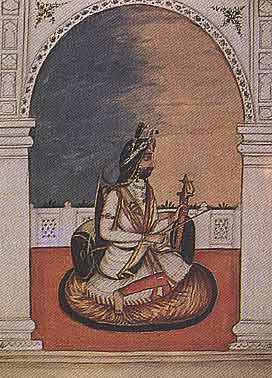
His
character was a compound of many conflicting qualities: crunching and mean to
his superiors, he was silent and suspicious with the equals; poised, superstitious
and arrogant with his inferiors; and subtle and deceitful to all.
In
the old age of Maharaja Ranjit Singh there was one person whom he specially took
into his favour and loved him like a son from his birth. This was Hira Singh,
the son of Raja Dhian Singh.
Ranjit Singh could hardly bear the boy out of
his sight, and from infancy he was sedulously taught to call the monarch Father.
As
Hira Singh approached manhood, the army also yielded its affection to the Maharaja's
favourite, and so it came to pass that the senile love of the old monarch, aided
by the inclination of a powerful army, suggested a dream of greatness to his father
and uncle, the powerful Dogra brothers, and led to the successive deeds of violence
by which it seemed likely that their ambitious design might be accomplished.
The
dream was that Hira Singh, the heir of their family, or at least the most promising
of the rising generation, might gradually succeed to the throne of Ranjit Singh.
Those, whom it would be necessary to sweep away, were the male members of the
Maharaja's family, and all ministers, advisers and chiefs who refused to join
the Dogra party.
At the time of the death of Raja Dhian Singh, Hira Singh appealed
to the army in the neighbourhood of Lahore, and exhorted them to avenge his father's
death, and also that of Maharaja Sher Singh on their murderers, Sardar Ajit Singh
and Lehna Singh and
their followers, and he held forth lavish promises of
reward from his father's treasuries. The murderers were destroyed to a man.
The
army then elected Dalip Singh, the infant son of Ranjit Singh, as Maharaja, and
(installed) Hira Singh as Prime Minister, in place of his father. Hira Singh appeared
all-powerful, but he had still more powerful enemies, and found a mentor in the
person of the Pandit Jalla, a man of the most repulsive character and of a most
tyrannical and ambitious spirit. He had been a tutor to Hira Singh in his boyhood
and the latter, being still a youth was entirely in his hands. Hira Singh was
indeed a poor copy of his father, whom he in vain attempted to follow. His character
was a compound of many conflicting qualities: crunching and mean to his superiors,
he was silent and suspicious with the equals; poised, superstitious and arrogant
with his inferiors; and subtle and deceitful to all.
No sooner was Hira Singh
in power than his actions, under the guidance of Pandit Jalla, without whom he
seemed unable to act, caused the greatest dissatisfaction in the army and intrigues
were specially afoot, having for their object, Pandit Jalla's downfall and death.
The leading spirit in this movement was Sardar Jawahar Singh, the brother of Jindan,
the mother of Dalip Singh.
The hatred against Pandit Jalla rapidly increased,
and loud demands were addressed to Hira Singh to give him up, to which the Prime
Minister refused to comply, and so turned the vengeance of the army against himself.
They
both fled with some men to Shahdara, were pursued, and after a running fight were
caught and slain: their heads were cut off and paraded through Lahore City.
The
(Sikh) army was responsible for the death of Pandit Jalla. In fact Hira Singh's
death was caused by his mistaken loyalty to his tutor and he showed the courage
of his race in his end. With Hira Singh was killed Sohan Singh, a son of Gulab
Singh. His father thus led for vengeance on the Sikh nation, which had killed
so many members of his family.
Gulab Singh therefore determined to ally himself
with the British and to leave the Sikhs to their doom.
The Sikh army especially
hated him for his having killed thousands of their number in the attack on him
in Lahore Citadel.
COMMENTS
At
the time of Ranjit Singh's death Hira Singh was twenty-one. On 3rd February 1836
Maharaja Ranjit Singh conferred the title of Farzand-i-Khas (meaning Special Son)
on Raja Hira Singh.
We learn from the Hindustani manuscript preserved in British
Library in London vide Accession Number Or. 1733 already referred to in this work
in the foot-notes of Chapters 8 and 9 that the charitable monuments issued from
Lahore Durbar contained the following words: Barai mazid iqbal-i-Sarkar-i-Wala
o tandrusti-i-Barkhurdar Asar-Iqbal Raja Hira Singh muafKardah shud..... The English
translation of this Persian phrase is : For the enhanced glory of His Excellency
and for the good health of sonny, the monument of grandeur, Raja Hira Singh, is
hereby granted gratis .......
. Ajeet Singh Baaghaa's work Mahabali Ranjit
Singh preserves the following glimpse of the disgrace, which attended the severed
heads of Hira Singh and Pandit Jalla:
The Sikhs brought to Lahore the heads
of Hira Singh and his kind guide and sentinel. They hung his head at Lohari Gate.
For some days Jalla's head was paraded from house to house and from shop to shop.
The women uttered carol sonorous and joyous:
Great Gods mill ground after
all! From Yama s home lecher had a call!
At last Jalla's head was thrown
to dogs. After some time his head was removed from Lohari Gate and hurled in a
ditch. Some days later a man retrieved it from there and placed it in a cell in
Gulab Singh's palace in Lahore. After a year and a quarter Gulab Singh came to
Lahore. He opened the door of the cell. Young ones of a parrot warbled music in
the skull:
Great God's mill ground after all! From Yama s home lecher had
a call!
RAJA RALIA RAM
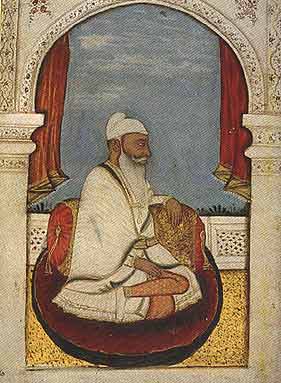
The
Lahore Government had few servants as able as Ralia Ram and his son Sahib Dial
and had none as honest.
Misar Ralia Ram was of a
respectable Brahman family, and had received an unusually good education. He was
well acquainted with Sanskrit, Persian and Physical Science.
He was placed
in charge of Amritsar District, and showed great courage in the suppression of
decoity and highway robbery.
Ranjit Singh was so pleased with his zeal that
in 1812 he made him Chief of the Department of Customs. At this time neither Kashmir
nor Multan nor the Derajat had been conquered, but as each was acquired, it was
placed under his management.
Before Ralia Ram was appointed, there had been
no regular system of collecting the Customs: each chief got as much out of merchants
passing through his territory as he could.
Ralia Ram largely increased the
revenue from Salt Mines of Pind Dadan Khan, and introduced the present system.
In
August 1846 both Ralia Ram and his son Sahib Dial were appointed to revise the
system of Imposts, and the Department of Customs for the whole country was placed
under them. The chief burden of the new arrangement fell upon Sahib Dial, for
his father was now an old man, and the greatest credit is due to Sahib Dial for
the zeal and ability with which he carried out the system.
Through the Panjab
War in 1848-49 Ralia Ram did important work.
Both Ralia Ram and Sahib Dial
were rich men. No one who ever held the farm of Salt Mines failed to grow rich,
for the Contractor
paid a certain sum to Government annually and might sell
as he pleased, at his own time and place. In the hands of so able a man as Ralia
Ram the Salt Contract was a certain source of wealth, while he in no way forgot
his duty to the State in regard to his personal interest.
The Lahore Government
had few servants as able as Ralia Ram and Sahib Dial, and it had none as honest.
They were, in the last corrupt days of the Administration, almost the only men,
who manfully supported it, and faithfully did their duty: and they had the wisdom
to understand and support the enlightened policy of the British Resident, the
only policy that could have saved the country from the evils that afterwards came
upon it.
In 1849 both Ralia Ram and Sahib Dial left the Panjab on a pilgrimage
to the holy cities.
Ralia Ram who had been made Diwan by the Sikh Government
in 1847, was in 1851 (when he was still on pilgrimage) created a Raja (by the
Successor-Government i.e. British Government), and Sahib Dyal (who was back to
Panjab in 1851 also) received the same title
Never were honours farther merited.
Raja
Ralia Ram never returned to Panjab. He died at Banaras in 1864.
RAJA SAHIB DIAL
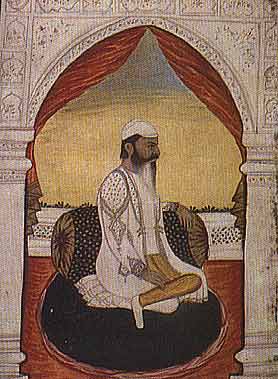
Sahib
Dial was a worthy son of his father Ralia Ram, with whose work he was associated
as has already been mentioned: he bore as high a character for honesty and ability
as did his father.
Sahib Dial first entered the Sikh service as Munshi in the
Customs under his father.
In 1832 he was transferred to the office of the Paymaster
of the regular army.
In 1839 he was made Chief of the Customs at Jalandhar,
and held this appointment till the close of the Satluj Campaign.
In 1846, under
the Sikh Durbar appointed by the British, the whole Customs Department of the
country was placed under the Superintendents Ralia Ram and Sahib Dial, while the
chief work was done by the latter, whose father was an old man.
In June 1848,
three months before the Multan Outbreak, a large number of disaffected men, under
a holy leader (Bhai Maharaj Singh) set out from Jhang to join the rebel Mul Raj
at Multan. None of the Sikh troops would attempt his arrest, but Sahib Dial, being
Kardar of Jhang where population was Muhammedan, attacked him vigorously with
the Muhammedan Chief's followers, and drove him into the swollen Chanab: more
than half were drowned, and those that escaped the storm and flood were taken
to Lahore as prisoners.
Again, when Raja Sher Singh marched from Multan, Sahib
Dial seized upwards of nine thousand mules, camels and bullocks
belonging
to the Raja, and this materially checked the advance of the rebel army.
In
November (1848), Sahib Dial was selected by the (British) Resident to accompany
him to the headquarters of the British army on the part of (Sikh) Durbar. In the
performance of his (pro-British duty, he showed the greatest intelligence and
grab. He provided excellent information of the movements of enemy (i.e. the Sikh
soldiery), and kept the (British) army well supplied with provision
Afterwards
he proceeded to join Col. Taylor in obtaining the submission of the principal
rebels, and was useful in discovering the rebels.
In 1849 Sahib Dial along
with his father left the Panjab on pilgrimage to the holy cities, and did not
return till 1851.
He received the title of Raja, which was well deserved.
During
the Mutiny of 1857 Raja Sahib Dial, by his advice an actions, showed his loyalty
(to the British) and received an addition; (annual) grant of jagir worth two thousand
rupees in perpetuity.
In 1864 Sahib Dial was appointed a Member of the Legislate
Council of Lahore.
He was much esteemed by the British Officers, who knew him
well and also by the natives of the country.
RAJA DINA NATH BAHADUR
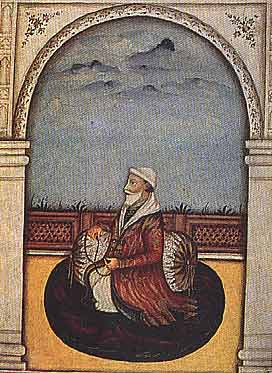
The
family of Raja Dina Nath came originally from Kashmir, where in the reign of (the
Mughal King) Shah Jahan, some members of it held offices relating to court affairs.
Dina
Nath, whose father had a subordinate appointment at Delhi, came to the Panjab
in 1815 and obtained a berth in the Estate Office at Lahore.
He first attracted
Ranjit Singh's notice in 1818 by the great rapidity and clearness with which he
did some important work entrusted to him.
Among the men who rose to power during
the later days of the Maharaja's life, no one was more remarkable than Raja Dina
Nath.
He was well and happily styled Talleyrand of the Panjab and his life
and character bore a strong resemblance to those of the European statesmen.
Revolutions
in which his friends and patrons perished passed him by: in the midst of bloodshed
and assassination his life was never endangered. While confiscation and judicial
robbery were the rule of the State, his wealth and power continually increased.
His
sagacity and far-sightedness were such that when to other eyes the political sky
was clear, he could perceive the signs of coming storm, which warned him to desert
a losing party, or a falling friend.
Honest men do not survive
many revolutions, and the Raja's falseness was the means to his success.
He
was patriotic, but his love of country was subordinate to self.
He hated the
English bitterly, for they were stronger than he or his country, but his interest
compelled him to serve, like Samson, the Philistines he hated.
He was not without
his notions of fidelity, and would stand by a friend, as long as he could do so
with safety to himself. Even when he deserted him it was more from thoughts of
danger to his wealth and influence than from personal fear, for, Raja Dina Nath
was physically brave, and also possessed moral courage in an eminent degree, though
it did not lead him to do right regardless of consequences.
He possessed immense
local knowledge and vast capacity for work; but his desire of keeping power in
his own hands had an evil effect on the progress of (State) business.
He was
an accomplished man of the world, courteous and considerate; well educated though
nothing of a scholar; and in conversation with Europeans he would express himself
with a boldness and apparent candour that were as pleasant, as they are unusual
in Asiatics.
It was only in 1834 that Raja Dina Nath was made Finance Minister
for which his qualifications were exceedingly high, but Maharaja (Ranjit Singh)
had for many years reposed confidence in him, and he was on all occasions of importance,
one of his most talented advisers.
After the death of Maharaja Ranjit Singh,
he retained great influence with the chiefs and the army, and on British occupation
of Lahore was appointed to the Council of Regency, of which he was the most able
and useful member.
Although his position as the Head of Financial Department
gave him many opportunities of enriching himself at the public expense, I of which
there is every reason to believe he availed himself, he still worked more disinterestedly
than others, and was of great service to the Resident of Lahore.
With
his clear head and business-like habits, it would have been almost impossible
to disentangle the Darbar Accountancy, and after the annexation of the Panjab,
Dina Nath's aid in Revenue and Jagir matters was almost as valuable as before.
At
the time of revolt of Sikh army in 1848, it was asserted by some that Raja Dina
Nath was a traitor at heart, that he himself had encouraged the rising, and that
had he not been a wealthy man with houses and gardens and many lakhs of rupees
in Lahore, convenient for confiscation, he would have joined the rebels without
hesitation, but these stories were perhaps invented by his enemies. Certain it
is that on being recalled to Lahore, he zealously carried out the wishes of the
British authorities in counteracting their (i.e. the rebels' anti-British) schemes.
After
the annexation of the Panjab, Raja Dina Nath was confirmed in all of his jagirs,
worth Rs. 46,460, which he held till his death in 1857.
FAQUIR AZIZ-UD-DIN
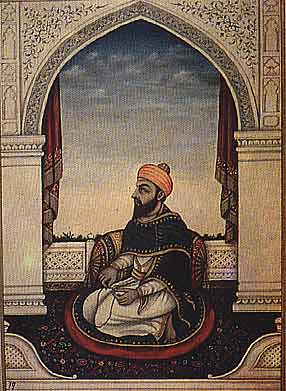
The
most conspicuous figure in the eyes of the foreigners visiting the Court of Maharaja
(Ranjit Singh) was his Foreign Minister Faquir Aziz-ud-Din. His father Ghulam
Muhaiy-ud-Din was a clever medical practitioner.
In 1799 the principal Lahore
physician, with whom Aziz-ud-Din was staying, placed the youth in attendance on
Ranjit Singh, when that Chief soon after his capture of Lahore was suffering from
ophthalmia. The skill and attention of the young doctor won the Chief's regard.
Aziz-ud-Din
received a grant of several villages, was appointed Personal Physician to the
Maharaja, and as Ranjit Singh's territories increased, the wealth and estates
of Aziz-ud-Din also increased.
It was his wise influence in 1808 which prevented
Ranjit Singh from declaring war with the British when they first curbed his power
by confining his conquests to the north of the Satluj.
The Maharaja was so
convinced of the wisdom of Aziz-ud-Din's advice on this occasion that he never
undertook any serious operations without consulting him.
In all matters connected
with the Europeans and the English Government Aziz-ud-Din was specially employed,
and to his enlightened and liberal counsels it may be attributed that throughout
his long reign the Maharaja maintained such close friendship with the English
Government.
Aziz-ud-Din was occasionally employed on military service, and
whenever it was necessary to send a special embassy, as to Lord William Bentinck
in 1831, and to Amir Dost Muhammad in 1835, the Faquir was always selected and
was always equal to the emergency.
The elaborately polished manners of Faquir
Aziz-ud-Din, and his exaggeration of flattery and compliment struck the foreigners
the more strangely at so rough and rude a Court as that of Lahore.
He was one
of the ablest and certainly the most honest of all the courtiers of Ranjit Singh.
Faquir
Aziz-ud-Din died in 1845 just before the crushing defeats of the First Sikh War.
With dying breath he protested against the march of Sikh army to Satluj, performing,
though in vain, his last service to both the English and the Lahore States.
The
younger brothers of Aziz-ud-Din, namely, Imam-ud-Dir and Nur-ud-Din, were both
important members of the Maharaja'; Court, though their position was not so conspicuous
as that of their elder brother.
FAQUIR SAYYAD NUR-UD-DIN
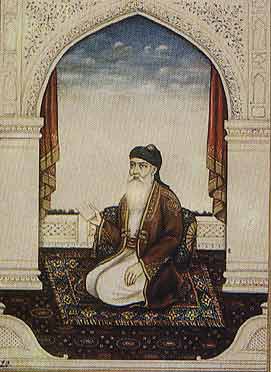
His
advice was generally sound, disinterested, and well considered.
Faquir Nur-ud-Din
possessed neither the ability nor the courage of his elder brother, the famous
Minister Faquir Aziz-ud-Din, whom in many points he much resembled.
From 1810
to 1818 Maharaja Ranjit Singh employed him in many civil capacities, in charge
of Districts etc. when his duties were multifarious and responsible, and he acquitted
himself well. He was then transferred to Lahore and was thenceforward generally
employed (on matters) about Court.
Nur-ud-Din was associated with his brother
in the conduct of negotiations with the British Government. Both were lovers of
the English and earnestly desirous that the two States of India and Lahore should
live on the most friendly terms.
After the War of 1846, when Raja Lal Singh
(re-appointed as Prime Minister) was deposed for treason (by way of instructing
the Governor of Kashmir, Imam-ud-Din to resist (the transfer of Kashmir to Gulab
Singh ratified by the Sikh-British Treaty signed on 9th March, 1846), Nur-ud-Din
was appointed a Member of the Council of Regency to carry on the administration
till the majority of the infant Maharaja Dalip Singh. (The newly constituted Council
of Regency supplanted Maharani Jindan who had been Regent since coronation of
her minor son Dalip Singh in September 1843).
His advice was generally sound,
disinterested and well considered. He was well rewarded for his services. He died
in 1852. Nur-ud-Din was known at Court as Khalifa Sahib, a title given by the
people to any one particularly honoured and revered by them. Nur-ud-Din especially
enjoyed a general respect in the country.
SARDAR HARI SINGH NALWA
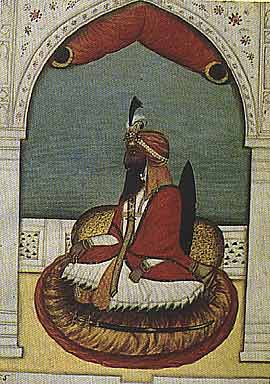
This portrait has been captioned as of S Hari Singh Nalwa. But the similarities in the other paintings of the Sardar do not match with this one. Personally I think this is not the portrait of S Hari Singh Nalwa. Look in the 'Warriors' section for more details on this great of the greatest warriors. (Kanwal)
The
most famous of the fighting chiefs, and the one to whom Maharaja Ranjit Singh
was most attached, was Hari Singh Nalwa, who was born, like Ranjit Singh himself,
at the town of Gujranwala.
He was not only the bravest
but also the most skilful of Maharaja Ranjit Singh's Generals, and was employed
to command all the expeditions of exceptional difficulty.
He was
chiefly instrumental in the capture of Multan in 1818, and in the following year
he commanded a Division of the army invading Kashmir, of which country he was
afterwards appointed Governor: but his talents did not lie in the direction of
administration, and he became so unpopular that the Maharaja was compelled to
recall him.1
After this he was chiefly employed on the Panjab Frontier, and
in 1836 he was ordered to build a fort at Jamrod to command the entrance of the
Khyber Pass. This work was soon finished. It was of no great strength, but was
sufficient to overawe the Afridis, and annoy any force marching from Kabul.
Amir
Dost Muhammad (Khan) was furious and determined to take up the challenge thus
thrown before his mountain Gateway. He detached from Jalalabad a force of 7000
horse and 2000 matchlock men with 18 guns under his son Muhammad Akbar Khan
accompanied
by his other three sons and joined by some 20,000 tribesmen.
They arrived in
April 1837 before Jamrod, then unprovisioned, and garrisoned by only 800 Sikhs.
Hari
Singh was ill with fever at Peshawar and made no sign, and the siege was set for
six days, when the walls were breached so that the cavalry might charge them.
For
some days the hostile forces lay opposite each other, neither wishing to attack,
for Hari Singh had in the meantime mustered his forces.
At length Hari Singh
decided on battle.
His advance was at first irresistible and the Afghans broke
and fled: but the Sikhs carried pursuit too far, and were overwhelmed by a charge
of Afghan horse.
Seeing that a desperate effort alone could retrieve the fortunes
of the day, Hari Singh rode to the front with his principal chiefs and by his
presence and example encouraged the Sikhs to stand.
The day might have been
won, but Hari Singh fell, mortally wounded by two bullets and his men, disheartened,
fell back under the walls of Jamrod and waited for reinforcements.
Thus fell
the gallant Hari Singh, the General of the Khalsa and the most dashing of Ranjit
Singh's chiefs.
Hari Singh had acquired as an officer in command of troops
in the field and in quarters, as well as a Governor of large districts an immense
number of estates and great wealth, but he had no sooner fallen in battle with
the Afghans than the ungrateful and unscrupulous Ranjit Singh seized all of his
large estates and left his widow and four sons to comparative poverty.
Twelve
years later, his second son, Jawahar Singh, distinguished himself by leading the
dashing Sikh cavalry charge against the British cavalry at Chillianwala.
COMMENTS
Dewan
Chand Sharma records in his work Kashmir under the Sikhs, Seema Publications,
Delhi, 1983 that Hari Singh Nalwa
took over as Governor of Kashmir on 24th
August 1820. In 1822, Lahore Durbar called him back for employment at Afghan border.
Sardar
Hari Singh Nalwa had four sons, Jawahar Singh and Gurdit Singh from his senior
wife and Arjan Singh and Panjab Singh from his second wife. Internecine dispute
between the two sets of half-brothers provided to Lahore Durbar the justification
for drastic truncation of the big estates bequeathed to his sons by Hari Singh
Nalwa. As a result of colossal confiscation of Hari Singh's estate, the annual
income from them amounting to Rs. 8,53,000 in the days of Hari Singh dwindled
after his death to Rs. 19,600. Sir John W. McQueen has not noticed the foregoing
background, which led to the posthumous shrinkage of Hari Singh Nalwa's estates.
SARDAR AJIT SINGH SANDHANWALIA
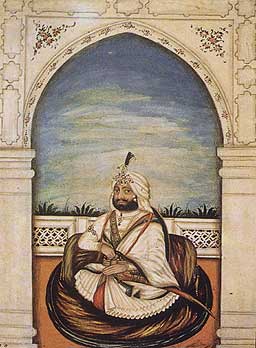
The
two principal families in the Panjab, highest in rank and possessing the widest
influence were the Ahluwalias, whose possessions were entirely in the Jalandhar
Doab, and the Sandhanwalias, who were supreme among Sikh families between the
Satluj and the Indus.
Nearly related to the Sandhanwalia family was the great
Maharaja Ranjit Singh himself, who belonged to a collateral branch, and it was
in a great measure owing to this connection, that the Sandhanwalia Sardars obtained
so large a share of influence and power.
In Ranjit Singh's time and / or in
that of his successors, five members of this family were distinguished as soldiers,
and two of their number perpetrated the treacherous murders of Maharaja Sher Singh
and Raja Dhian Singh on the same date i.e. the 15th September, 1843.
Sardar
Atar Singh Sandhanwalia was the chief of the family both by age and ability, and
after the death of General Hari Singh Nalwa, who was killed at the Khyber, Atar
Singh Sandhanwalia was called the Champion of the Panjab.
Sardar Atar Singh
Sandhanwalia's younger brother Sardar Budh Singh Sandhanwalia was one of the bravest
and most skilful of the Sikh Generals. He died in 1827.
Sardar Atar Singh
Sandhanwalia's youngest brother Sardar Lehna Singh Sandhanwalia saw much service
in the Peshawar border and elsewhere. He was a man of energy but illiterate and
debauched.
Lehna Singh Sandhanwalia and his nephew Sardar Ajit Singh Sandhanwalia
and their followers were concerned in the murders of Maharaja Sher Singh and Raja
Dhian Singh.
Sardar Budh Singh Sandhanwalia's son Sardar Shamsher Sandhanwalia
was a gallant and trustworthy soldier and averse to politics vide .
Sardar
Ajit Singh Sandhanwalia was brave but also headstrong and rash.
When Maharaja
Kharak Singh and his son Nau Nihal Singh died, the widow of Kharak Singh, Maharani
Chand Kaur, laid claim to the throne. She was opposed by Ranjit Singh's reputed
son Sher Singh and supported by Raja Dhian Singh.
After a great delay, caused
by intrigues, and a hard fighting, Sher Singh became Maharaja.
Sardar Atar
Singh Sandhanwalia, Sardar Lehna Singh Sandhanwalia and Sardar Ajit Singh Sandhanwalia,
who supported Rani Chand Kaur, fled from the Panjab but after a time the two latter
returned, when Sher Singh imprisoned them and deprived them of their jagirs.
After
six months they were released and their jagirs restored.
They appeared to be
very grateful to the Maharaja and the Prime Minister, but when they had fully
established themselves in favour, they began their intrigues, telling the Prime
Minister that the Maharaja wanted to get rid of him, and on the other hand telling
Sher Singh that they had been asked by Dhian Singh to murder him. They offered,
however, to murder Dhian Singh if given a written order to protect themselves.
This they obtained and also received permission to go to their estates to bring
up their soldiers and followers to carry out the design. They showed the written
order to Dhian Singh and he believed that it was their purpose to bring their
followers to murder the Maharaja which was part of their plot.
On the return
of the Sandhanwalia Sardars, it was arranged that the Maharaja should inspect
their troops, six hundred strong. Sher Singh, however, did not inspect them at
the appointed time: so Lehna Singh Sandhanwalia and Ajit Singh Sandhanwalia went
with their men, to his favourite home, three miles from Lahore, and taunted him
in jocular manner for keeping them waiting. They had armed themselves with two
magnificent double-barrelled guns. When they came up close to Sher Singh, Ajit
Singh, who was carrying his gun in his hands, suddenly fired the contents into
the Maharaja's body and the cuts of a sabre finally ended the life of Sher Singh.
They killed several of his followers, Lehna Singh killing the young prince Partap
Singh, and Ajit Singh entering into the harem, and murdering all of Maharaja's
women.
SARDAR LEHNA SINGH
SANDHANWALIA
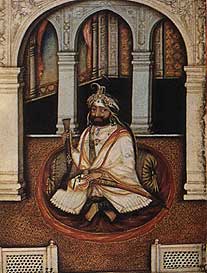
The
account of Lehna Singh is given in above chapter .
It is well worthy to record
the gallant conduct of a Lehna Singh's follower. Ran Singh, faithful unto death,
and the chivalry of the attacking Sikhs.
The fight being over in Lahore Fort,
a search was made for Lehna Singh, who had disappeared from the fight, and was
not found among the dead. He was soon discovered in a dark and secret subterranean
cell to which, with a broken thigh, he had retired the night before. He was attended
by one faithful follower, who defended his master to the last, but all in vain.
The
name of this gallant man was Ran Singh, a strong and large-bodied Sikh of about
fifty. On being recognised as he stood, sword in hand, at the entrance of his
master's retreat, he was repeatedly entreated, both by Lehna Singh and his enemies,
to sheath his weapon and make his escape while he could do so. But he disdainfully
refused to avail himself of forbearance of the enemy, requesting only that they
should not fire on him but attack only with their swords and the Sikhs knowing
him, and admiring his bravery, actually complied with the request.
They
rushed on him with their swords, and after killing thirteen of them, he himself
fell, covered with wounds. His dying petition was, only, that they would not kill
his master, and to this request they also promised compliance.
But some bad
spirit among them shot Lehna Singh from behind, exclaiming as he did so, "Are
we going to lose ten thousand rupees?" But this man was immediately killed
by his own comrades. They, however, cut off the head of the fallen chief, and
sent it to Hira Singh, who doubtless gave them the stipulated reward.
SARDAR BUDH SINGH SANDHANWALIA
Sardar Budh Singh Sandhanwalia
began as a soldier early and soon rose to high command. He was in command of a
portion of the Sikh army at (Tibba) Teeree near Nowshehra in the Peshawar valley.
It was a most critical contest and decided, once for all, whether the Sikhs or
Afghans should rule in Peshawar.
Maharaja Ranjit Singh, on the left bank of
River Indus won a severe battle against the Yusufzais, and Sardar Hari Singh Nalwa
and Budh Singh Sandhanwalia defeated the Afghan army, which returned through Khyber.
In
1825 Ranjit Singh was dangerously ill at Amritsar. Budh Singh, who was sure that
on the death of the Maharaja, the whole country would again be divided under different
chiefs, determined to provide (territory) for himself. He endeavoured to take
Gobind Garh Fort at Amritsar by surprise, but the Commandant declined to open
the Fort Gates at night, even to the Maharaja himself, though a forged order was
produced.
So the plot failed: and the Maharaja recovering, and hearing the
story, thought change of air on the Attock border advisable to Budh Singh. Here
he did excellent service. At Akora he fought Sayyad Ahmed Shah (Barelvi) and defeated
him, but lost 500 men. The next day he advanced to Jahangiria to be joined by
large reinforcements surrounded by the Sayyad's army in overwhelmingnumber, but
Budh Singh suddenly led his men out, and after a severe fight defeated the enemy
with great slaughter.
The Sayyad took refuge in Yusufzai hills, and did not
return to take the field for two years.
After this success Sardar Budh Singh
returned to Lahore where he was received with all honours, but a few months later
in 1827 he died of cholera.
The Maharaja wrote a letter to his family expressing
his grief (over his death), and his regret that so brave a man should have died
in his bed.
Sardar Budh Singh Sandhanwalia was one of the best and most skilful
of the Sikh Generals.
SARDAR SHAM SINGH
ATARIWALA
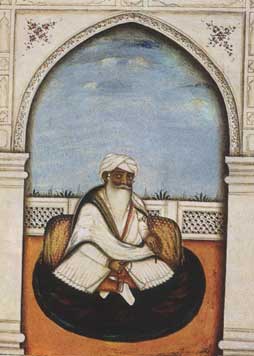
...
he swore on the Granth, never to leave the battle defeated.
Sardar
Sham Singh Atari, who was killed at Sabraon, was one of the noblest and best of
the Sikhs.
He had denounced the war with the British, and well foresaw what
its termination must be. But he resolved to fight for the Khalsa, and on the night
before Sabraon he swore on the Granth, never to leave the battle defeated.
In
the morning he dressed himself in white, and having mounted his white mare, addressed
his men, begging them, as true sons of the Khalsa, to die rather than yield.
During
the first part of the battle, he was everywhere present, urging the Sikhs to fight
bravely and it was not till he saw that was lost that he spurred forward against
the 50th Regiment, waving his sword and calling on his men to follow him.
Some
fifty of them obeyed his call, but were driven into the River Satluj, and Sham
Singh fell dead from his horse, pierced with seven bullets.
After the battle
his servant begged permission to search for his body. The old Sardar, conspicuous
by his white dress and long white beard, was discovered where the dead lay thickest.
His
servant placed his body on a raft and swam with it across the river, but it was
not until the third day that it reached his home at Atari.
His widow, who knew
his resolution not to survive defeat, had already burnt herself with clothes,
which the Sardar had worn onwhich marks the spot, where it took place, is still
standing outside the walls of Atari.
From this it will be noticed that the
British Government had no difficulty in putting an end to the practice of Sati,
but it was difficult to put an end to another fearful crime of female infanticide.
This
latter custom in the time of Guru Gobind Singh and upto the time of British annexation
of the Panjab was very prevalent, especially in higher castes, such as the Rajpoots,who
had greatest difficulty in disposing of their daughters. As an example may be
mentioned the Rajput house to which Maharaja Gulab Singh belonged: the practice
was invariable.
No marriage of a daughter is known to have taken place in the
family until 1871, when Maharaja Gulab Singh's grand-daughter was married to the
son of ancient Jaswal House.
Despite prohibition of Guru Gobind Singh, the
practice of infanticide long remained common among the Sikhs, and even today there
are parts of the Panjab, where, especially in sacerdotal Sikh families, the practice
is suspected to prevail, but as a rule it may be said, that British influence
has put an end to this cowardly and infamous crime throughout the Panjab.
The
murder of the infant which was performed with all due ceremony, was done as follows:
a piece ofgur (raw sugar) was put into the infant's mouth, which was then stuffed
with cotton thread, a doggerel rhyme being chanted:
(Gur kha te sut kattl Apja
te munda ghatt!!)
This may be roughly translated thus:
Eat gur and spin
thread!
But go, and send a boy instead!!
SARDAR
SHAMSHER SINGH SANDHANWALIA
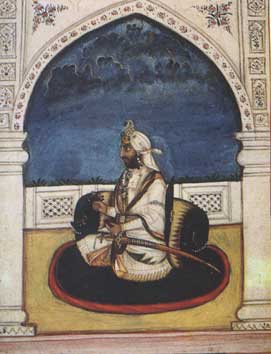
Sardar
Shamsher Singh, a son of the famous General Budh Singh, was recalled from Peshawar,
and placed in command of a Brigade of Regulars, which he commanded throughout
the Satluj Campaign of 1845-46.
In 1846, he was appointed a Member of the Council
of Regency. I
In February 1848, the (British) Resident at Lahore deputed! Shamsher
Singh to the districts about Amritsar, known as Majha, placing under him Civil
and Military establishments. This tract o| country was infested with robbers,
chiefly disbanded soldiers, and the Sardar acting with considerable energy, restored
it to some degree of quiet.
Previous to this he had served some time at Bannu
under Lieutenant Edwardes.
On the outbreak of rebellion of Multan, Shamsher
Singh was sent down there in command of one Division of the Sikh army. He warned
Edwardes of the disaffected state of the troops and did his best to keep them
faithful (to the British).
The mutiny at last took him by surprise, and he
was carried off by Raja Sher Singh (Atariwala) into Multan, where, before the
whole Durbar, he refused to join the rebel cause, and declared that he owed obedience
to Maharaja (Dalip Singh) only.
The next morning on 15th September 1848, he
succeeded in making his escape, on foot, from (Raja) Sher Singh (Atariwala's)
camp, leaving behind him all his tents and elephants: on the road he was intercepted
by two of the rebels but he shot one, and the other took flight.
After his
return to Multan, he rendered good assistance 'to General Whish in furnishing
information of movements of Ram Singh, son of Shama, Vizier of Nurpur (State),
who was in open rebellion (against the British).
After Annexation, the personal
jagirs of Sardar Shamsher Singh, amounting to Rs. 40,250 per annum were upheld.
During
Mutiny in 1857, Shamsher Singh raised troops of 125 horsemen (for helping the
British).
Shamsher Singh was made Magistrate in his own jagir and a month later
his jurisdiction was extended to Dacoity.
SARDAR MANGAL SINGH RAMGARHIA
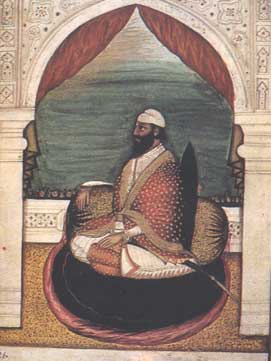
It
has been in a great measure owing to his influence and example, that the cause
of female education has been so widely systematically taken up in Amritsar.
There are two men of this name, and as the accompanying potraits provide
no clue of race and family of either, (available) short accounts of both are entered
herewith.
In 1834 Sardar Mangal Singh Ramgarhia was sent to Peshawar to command
400 foot and 110 Sawars of the old Ramgarhia class. There, under Sardar Tej Singh
and Sardar Hari Singh (Nalwa), he did good service, and fought in the famous Battle
of Jamrod in April 1837, where the gallant Hari Singh was killed.
During the
reign of (Maharaja) Sher Singh, he was employed in Suket, Mandi and Kullu, and
remained there till the close of Satluj War in 1846.
During the Second Sikh
War, Sardar Mangal Singh did excellent service in guarding the roads, and in maintaining
order in Amritsar and Gurdaspur Districts.
In 1862, on the retirement of Sardar
Jodh Singh, Sadar Mangal Singh was appointed Manager of the affairs of the Sikh
Temple of Amritsar. His appointment, which was of some difficulty, was filled
by the Sardar with tact and ability. In the same year he was appointed Honorary
Magistrate of Amritsar.
Sardar Mangal Singh was a man of education and liberal
ideas.
It has been in a great measure owing to his influence and example, that
the cause of female education has been so widely systematically taken up in Amritsar.
(Mangal
Singh Ramgarhia was son of Jodh Singh Ramgarhia and grandson of famed Jassa Singh
Ramgarhia.)
SARDAR MANGAL SINGH SINDHI
.Though no Courtier, Sardar
Mangal Singh was a clever man and he rapidly rose to favours at Court.
Prince
Kharak Singh gave to him jagirs worth five thousand rupees, and the charge of
Chunian in Lahore District.
The Prince was so pleased with the activities of
Mangal Singh in this appointment that in 1820, with (Maharaja) Ranjit Singh's
approbation, he made him Manager of his all Civil and Military affairs.
After
the death of Kharak Singh, Sardar Mangal Singh did not meddle with politics, and
gradually fell into background.
He was a plain soldier and judicial work in
no way suited him.
When the rebellion broke out in 1848, he was at Wazirabad,
and was placed in charge of the Ferries: according to his own conduct, he was
taken prisoner by Raja Sher Singh (Atariwala), when opposing the passage of the
rebel force and kept under restraint till just before the Battle of Ramnagar,
when he effected his escape and joined Major Nicholson under whose orders he remained
till the close of Campaign.
The conduct of Sardar Mangal Singh appeared suspicious
to the authorities, and, after Annexation, only a cash pension of twelve thousand
rupees was allowed him for life.
But it must in fairness be remembered, that
no treason was ever proved against the Sardar, that he joined the British at a
critical time and that he was employed in procuring supplies and resources for
the British army upto the very end of War.
Sardar Mangal Singh died in 1864.
AKALIS AND THEIR TEMPLE AT AMRITSAR
The Akalis were
an unmitigated nuisance and danger during Maharaja Ranjit Singh 's reign, and
more than once they attempted (termination of) his life.
Opposite
the Golden Temple of Amritsar stands the Temple of the Akalis, which, at the present
day, exhibits more of the original character of the Sikhs as established by their
founder (Guru) Gobind Singh than that is to be met among the common Sikhs.
Since
the days of Ranjit Singh the Akalis have greatly degenerated and are to be found
mixed with men of such low castes as Mazhabis, a practice which their distinguished
Chief now continued: a true Akali of the original Jat stock is now to be rarely
met with except at different Akali Bungas such as at Amritsar, Tarn Taran and
Anandpur.
The real Akali was bold, free and in particular haughty and audacious
to those who dared to call or think themselves his superiors. He chose to strive
to win the character of a friend to the poor and an enemy of the vile and powerful.
He was a fanatic in religion and followed strictly all the rules laid down for
his guidance by the great Guru Gobind Singh.
He made no scruple of seizing
or demanding from a friend whatever he required, but he was equally ready to over-repay
an obligation. He cared little for wealth, but was content with the mere accessories
of existence. He was regardless of life and willingly exposed his self to danger
at the call of duty or religion.
The Akalis were dreaded by the Sikh Chief
(Ranjit Singh) for their fanaticism and turbulence, and they often levied offering
byforce. Maharaja Ranjit Singh was afraid to interfere too closely with them,
for though little better than drunken stooges (of Guru), they were supposed by
the Sikhs to possess a semi-sacred character, and were, moreover, useful when
sober desperate deeds were to be done, which the rank and file of the army might
have declined.
In 1809 the Akalis nearly embroiled the Maharaja with the English
by their fanatical attack on Metcalfe's Muslim escort. The steadiness with which
the escort repulsed the raging mob of Akalis made great impression on Ranjit Singh,
and he determined to train and discipline his troops on the European pattern.
The
reckless valour of the Akalis or Nihangs turned many a wavering Sikh fight with
victory. They were identical in character, and in manner of their onslaught with
the Ghazis of Afghanistan and Sudan, whose fierce and terrible attack shakes the
heroes of all but the steadiest and most trained troops. But the Sikh soldiers
of God drew their courage more from drink and maddening drugs, than from the disciples
of religious enthusiasm, which inspires the wild children of Islam.
The Akalis
were an unmitigated nuisance and danger during Maharaja Ranjit Singh's reign,
and more than once they attempted (termination of) his life.
Their insolent
swagger and hatred of Europeans made them so obvious during the early years of
British rule in Panjab that the visits to the Golden Temple of Amritsar, where
the Akal Bunga formed their headquarters, were always attended by the Priest.
The
Akali dress is peculiar. The men wear the checkered clothes, bangles on the wrists
and quoits of steel on their blue conical turbans, together with miniature daggers
and an iron chain.
Their headquarters used to be at (Sri) Amritsar (Sahib),
when they assumed the direction of religious ceremonies, and the duty of working
the Council of Khalsa.
They were married priests, political rather than religious,
and their Order is dwindling away, numbering only 547 at the last census.
Their
present headquarters are said to be at (Sri) Anandpur (Sahib) in Hoshiarpur District
(in Panjab).
They still pride themselves upon the purity with which they preserve
the original ordinances of their religion, rejecting all Hindu rites even in their
marriage ceremonies.
COMMENTS
1.
Guru Nanak founded Sikhism. Guru Gobind Singh created the Order of the Khalsa.
In between, Guru Arjan conceived the necessity of and Guru Har Gobind completed
what the Sikhs originally called Akal Bunga and later named it Akal Takht. Bunga
is the Panjabized form of the Persian word Bungah which according to the Persian-English
Dictionary compiled by S. Haim means Institution or Establishment. In his Panjabi
work Mahan Kosh, Bhai Kahan Singh Nabha does record that Bungah is a Persian word
but he maintains that this word means abode.
2. Academically Sikhism rejects
caste divisions. We do not quite accept Sir John W. McQueen's view that because
from the days of Ranj it Singh the Mazhabis outnumbered Jats in Akali ranks, the
change is interpretable as Akali degeneration.
3. On the occasion of the Muharram
anniversary, the Akalis prevented the procession of Shia Muslims of Charles Metcalfe's
escort from closely approaching the Holy Durbar Sahib in Amritsar which caused
the scuffle.
It was not the superior Muslim performance in the aforesaid combat
which inspired Ranj it Singh to train his troops on the European pattern. We learn
from Diwan Amar Nath's Persian work Zafar Namah-i-Ranjit Singh that Ranjit Singh
haD Europeanized his army as early as in 1803.
4. The Nihangs love to swill
the intoxicating hemp which they call Sukhnidhan meaning Treasure of Comfort.
BHAI GURMUKH SINGH
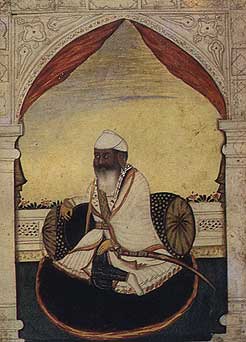
Throughout the reign of (Maharaja) Sher Singh, Bhai Gurmukh Singh intrigued against Raja Dhian Singh, and joined with the Sandhanwalias in conspiracy against the Raja' s life.
Bhai Gurmukh Singh was the son of (Giani) Sant
Singh, the Guardian of the sacred Temple of the Darbar Sahib at Amritsar.
(Giani)
Sant Singh had been a soldier as well as a priest. He served with the army on
several occasions with great credit.
When (Giani) Sant Singh gave up worldly
affairs and devoted himself to the reading and expounding of the Sikh scriptures,
he sent his son Gurmukh Singh to (Maharaja Ranjit Singh's) court.
The youth
soon became as great a favourite (of Maharaja Ranjit Singh) as his father had
been, although his influence was never equal to that of his enemy and rival Bhai
Ram Singh.
When Sher Singh became Maharaja, he did not forget the services
of Gurmukh Singh, whom he treated with great consideration and gave large jagirs.
But the real power was kept by the Prime Minister Dhian Singh in his own hands.
Though Maharaja Sher Singh hated Dhian Singh, and knew his unpopularity with the
nation, he could not get rid of him. He, however, played off Bhai Gurmukh Singh
against Dhian Singh, and the Bhai, from his religious character, and long friendship
with the Maharaja could not be excluded from the latter's presence.
But otherwise
the contest between the statesman and the priest, was most unequal. Gurmukh Singh
was supported by no powerful party and was without character or ability, while
Raja Dhian Singh was the ablest man of his day, subtle, plausible and cautious,
though held even to audacity in attacking and destroying his declared enemies.
Throughout
the reign of (Maharaja) Sher Singh, Bhai Gurmukh Singh intrigued against Raja
Dhian Singh, and joined with the Sandhanwalias in the conspiracy against Raja
Dhian Singh's life.
When the murdered Prime Minister Dhian Singh's son, Raja
Hira Singh, rose to power, he, at the instigation of Bhai Ram Singh and Misar
Lal Singh, arrested Bhai Gurmukh Singh with his friend Misar Beli Ram, the Treasurer,
and made them over for custody to Saikh Imam-ud-Din Khan, by whom they were put
to death.2
Bhai Ram Singh was a far abler man than his rival Gurmukh Singh,
but of no higher character. Both were unscrupulous and scheming and both made
religion a cloak for their ambition and intrigue.
COMMENTS
1.
Bhai Ram Singh was one of the grandsons of the holy personage Bhai Basti Ram (1708-1802).
On an occasion Ajeet Singh Baaghaa accompanied by the author of Plato and the
True Enlightener of Soul, Bhai Dharmanant Singh, called at Bhai Ram Singh's grandson
Principal Inder Singh. In the brief parley which ensued Sardar Inder Singh dwelt
upon the sanctity of his ancestor Bhai Basti Ram and observed amid rhapsodic wonder
that whatever he was he owed to the spiritiaul glory of Bhai Basti Ram.
2.
From the Hindustani manuscript preserved in London's British Library vide Accession
Number Or. 1733 we learn that hounds let loose on Beli Ram buried waist-deep in
ground devoured his upper half body.
SARDAR FATEH SINGH KALIANWALA
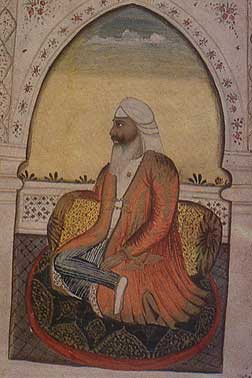
Fateh
Singh Kalianwala entered the service of Ranjit Singh in about 1798 and rose very
rapidly in the favour of his master.
He was a brave and skilful soldier, and
had ability and great influence.
He was with the Maharaja when he captured
Lahore and (also when he) took Amritsar from the Bhangi and Ramgarhia confederacies
and also at the defeat of Jodh Singh of Wazirabad.
It was, in a great measure,
owing to Kalianwala's advice that in 1805 Ranjit Singh gave no response to Jaswant
Rao Hulkar's cause against British Government.
On one occasion, at Wazirabad,
Maharaja Ranjit Singh told Fateh Singh Kalianwala to draw his troops (in the army)
on one side so that he might judge their number. When this order was given, (i.e.
when Fateh Singh's adherents in the army were asked to move towards him and the
rest of the soldiery was asked to cross towards Maharaja,) the whole army went
over to the Great Chief Kalianwala, and Ranjit Singh, to his rage and chagrin,
found himself almost deserted.
Ranjit Singh never forgot the
aforesaid incident: nor he forgave the Chief who had too much influence with the
army.
Many of the chief barons were proud to fight beneath Fateh Singh's command.
In
1807 Ranjit Singh beseiged Narain Garh Fort. For fifteen days it held out, but
Ranjit Singh became very impatient at delay, and (in ironic bid) told Fateh Singh,
who was in immediate command, that he was fond of remaining by Maharaja than of
leading the troops in the field. Piqued at this, Fateh Singh assailed the fort,
but was repulsed and mortally wounded.
Ranjit Singh came to the tent of the
dying Sardar who is said to have advised the Maharaja never to raise another Jat
Sikh to the highest office in the State. It is doubtful whether such advice was
ever given, but the Maharaja appears to have acted upon some such principle for
which his Officers and Generals were Jat Sikhs: in the Council he rather gave
his confidence to Brahmans, Rajputs and some Muhammedans.
Fateh Singh left
his son behind him and Ranjit Singh might have resumed all of his jagirs, but
feeling some remorse for the Sardar's death, he sent Mit Singh, with a khilat
for the widow (of the deceased) to ask her to nominate her husband's heir, who
should be recognized.
Dhanna Singh and Dal Singh were the two favourites of
Fateh Singh, but the latter having bribed Mit Singh with five thousand rupees
on the night of his arrival at (Fateh Singh's native place known as Kalian), Mit
Singh told the widow that although she might nominate any of the two, but Ranjit
Singh would recognise Dal Singh only, and he was accordingly selected.
COMMENTS
1.
Jodh Singh of Wazirabad and his brother Dal Singh were maternal uncles of Maharaja
Ranjit Singh's father Mahan Singh.
SARDAR ATAR SINGH SANDHANWALIA
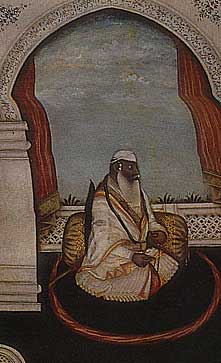
...
after the death of Hari Singh Nalwa at the battle which was fought at the mouth
of Khyber Pass, Atar Singh, who, for his strength and courage, was considered
the Champion of the Khalsa, became the Commander-in-Chief on the Peshawar border
(and held that position) till 1840.
Sardar Atar Singh was
a Chief of the most powerful family in the Panjab i.e. the one to which Maharaja
Ranjit Singh himself belonged.
The Sandhanwalias were a turbulent race and
Atar Singh, his brother Lehna Singh and nephew Ajit Singh were all conspicuous
by the intrigues which preceded and followed the death of Ranjit Singh.
Both
Atar Singh and his brother Budh Singh, who was a famous General who died twelve
years before Ranjit Singh's demise, saw much service in different parts of Panjab,
especially in Peshawar valley, and after the death ofHari Singh Nalwa at the battle
which was fought at the mouth of Khyber Pass, Atar Singh, who, for his strength
and courage, was considreed the Champion of the Khalsa, became the Commander-in-Chief
on the Peshawar border (which position he held) till 1840.
Sardar Atar Singh
supported Chand Kaur's party against Prince Sher Singh and the Prime Minister
Raja Dhian Singh, and left his estates when they came into power. With a large
following, he encamped in the (British)-protected Sikh States south of the Satluj
and, unlike Lehna Singh and Ajit Singh did not return (to the Panjab Kingdom),
because he did not trust Maharaja Sher singh and his Prime Minister Raja Dhian
Singh, though Atar Singh must have known of the intention of Lehna Singh and Ajit
Singh to murder the Maharaja and his Prime Minister. He continued stationed south
of theSatluj.
The Prime Minister Hira Singh believed Atar Singh to be privy
in the conspiracy (which culminated in mortal attack on Raja Dhian Singh) and
determined on his destruction: with this object he caused letters to be forged,
purporting to be from the chiefs and leaders of the army, and sent to Atar Singh,
urging him to return to Panjab, recover his influence and destroy Prime Minister.
He also sent forged letters to Baba Bir Singh, a Guru much respected by the Sikhs,
begging him to use his influence with the Sardars to effect the requisite return.
This ruse was successful and Atar Singh crossed the Satluj with his followers
and joined the camp of Baba.
The Sikh army would not, however, attack the camp
of the Holy Guru, and Hira Singh had recourse to further deceit in assuring the
troops that Atar Singh had allied himself with the British who were, even then,
ready to cross the Satluj and seize the Panjab and that if the army marched against
him, he would probably return to Sikh States south of Satluj without offering
any resistance. The troops, thereupon, marched from Lahore and all turned as Hira
Singh hoped.
By treachery, a triumph was excited, and before the Sikh soldiers
were aware (that Hira Singh had inveigled them for personal and not Panthic cause),
they were engaged in a regular fight with the Sandhanwalia's force. The camp of
Baba was stormed and he was killed by a round shot.
The late Maharaja Ranjit
Singh's son Prince Kashmira Singh was killed fighting gallantly.
Atar Singh
was shot by Sardar Gulab Singh Kalaudia. The tragedy took place in May 1844.
SARDAR
CHET SINGH BAJWA
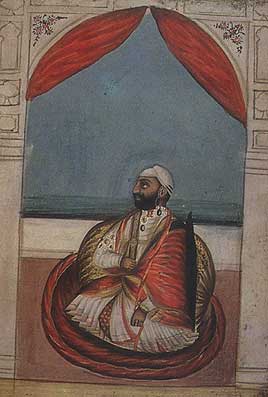
Chet
Singh's elevation was the cause of his destruction.
During Maharaja Ranjit
Singh's reign, he remained the chief favourite of Prince Kharak Singh and his
influence was very great, but after the death of Maharaja Ranjit Singh and the
accession of Kharak Singh to the throne, the Sardars whose jealousy Chet Singh
had aroused, determined to destroy him.
Raja Dhian Singh, then Prime Minister
and Prince Nau Nihal Singh were the leaders of the conspiracy (against Chet Singh)
and the unfortunate favourite was murdered in the palace almost in the presence
of his Master.
Raja Dhian Singh and his two brothers, Raja Gulab Singh and
Suchet Singh, with several Sardars, went into the fort at night and forced their
way into Maharaja Kharak Singh's bedchamber in the palace.
Alarmed by the noise,
and fearing danger, Chet Singh hid himself in a dark chamber to the rear of the
Monarch's apartment.
Maharaja Kharak Singh was surprised and bound and feared
death, which would certainly have been his fate but for the presence of his son
Nau Nihal Singh and the instructions of the latter's mother Chand Kaur, who had
stipulated that nobody should appear before the Maharaja.
After search, Chet
Singh was discovered in a corner with a drawn sword held in both hands but without
the power to use it, and trembling with fear, the coward wept and cried like a
child for mercy.While he was dragged into the presence of Raja Dhian Singh, the
latter, with his own hand, twice drove a long knife into his body and the unfortunate
favourite was literally hacked to pieces by the infuriated assassins.
Afterwards
Maharaja Kharak Singh was confined in the fort and Prince Nau Nihal Singh was
proclaimed (de facto) Maharaja: the old sovereign was declared an enemy to the
State and incapable of holding the reins of Government.
SARDAR
HUKAM SINGH MALWAI
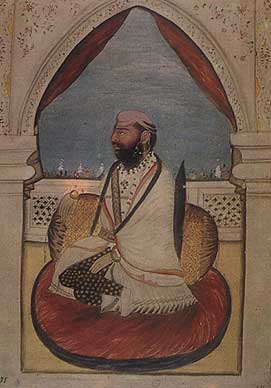
In
the later years of (reign of) Maharaja Ranjit Singh, Hukam Singh saw much service
as a young Sikh Sardar.
When Maharaja Sher Singh came to the throne, he, having
crowned him well, employed him and added eagerly to his personal estates.
He
was present in the Shah Bilawal Garden when Maharaja Sher Singh was assassinated
by the Sandhanwalias and in the struggle, was severely wounded in the shoulder
Little
is known of Hukam Singh during the two following years when he appears to have
lived retired life
He was killed at the Battle of Sabraon in February 1846.
SARDAR RANJODH SINGH MAJITHIA
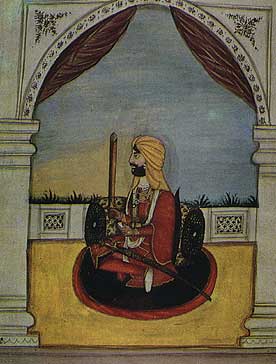
Sardar
Ranjodh Singh was a General in the (Sikh) army at the commencement of the Satluj
Campaign and was quite prepared for a war with the English.
He moved to Philaur
his troops consisting of ten thousand infantry and some regular cavalry with sixty
guns and on 17th January 1846 crossed the Satluj, intending to proceed to Ludhiana
to capture, if possible, the siege train which was on its way to the headquarters
of the British army at Baddowal.
On 21st January 1846, he intercepted the force
of Sir Harry Smith, who was marching to Ludhiana and, more from exhaustion of
the British troops than from any display of gallantry on his part, captured almost
all the baggage of the army.
This affair much encouraged his troops, who had
been joined by a fresh force at Aliwal on 28th January 1846.
Ranjodh Singh's
Generalship was as contemptible as that of Raja Lal Singh and his cowardice as
conspicuous as that of Raj Tej Singh: but he was not a traitor. He had no confidential
agent in the British Camp as Raja Lal Singh had: nor did he, like the latter secretly
wish for the triumph of the British.
During the Outbreak at Multan in 1848,
he was detected in treasonable correspondence and was placed in confinement. He
was released at the close of war. The Lahore Darbar confiscated jagir but granted
him a pension of three thousand rupees per annum.
SARDAR JAWAHAR SINGH
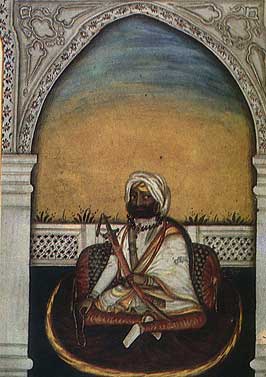
On
the murder of Raja Hira Singh, Maharani Jindan appointed as Vizier, her brother
Sardar Jawahar Singh, an ambitious, unscrupulous, drunken and debauched man.
Jindan's
first object was to employ Sikh army against Raja Gulab Singh to whom they bore
a grudge and hoped to rob him of his vast treasures.
After some severe fighting
at Jammu, Gulab Singh, conscious that from a military point of view, he was powerless,
determined to trust to intrigue and assuring them that he was but the servant
of the Khalsa, placed himself unreservedly in the hands of the Army Council.
He
was brought to Lahore, virtually a prisoner, and used his opportunities to conciliate
the army and turn their hostility against Jawahar Singh: after paying a fine of
some thirty lakh rupees, Gulab Singh cleverly persuaded the soldiers to permit
him to return to Jammu.
Ranjit Singh's son Pashaura Singh now revolted a second
time and as it seemed likely that the troops would depose the boy Maharaja Dalip
Singh in favour of Pashaura Singh, the latter was murdered by Raja Chatar Singh
and Sardar Fateh Khan Tiwana, it was believed, by Jawahar Singh's orders.
The
army, in consequence, was much enraged against Jawahar Singh and sent him word
that he was no longer Vizier.
The Army, after deliberating for fifteen days,
summoned him on 21 st September 1845.
He came on elephant, holding his nephew,
the young Maharaja,
in his arms. Maharani Jindan accompanied on another elephant.
Jawahar
Singh had four hundred horsemen as escort and two lakh
loads of rupees for
bribes.
As soon as the cavalcade left the fort, an ominous silence pervaded
the army: one hundred and eighty guns were fired but so stern was the discipline
that no sound was heard (in the army ranks). In the trampling of the escort, after
the salute died away, Dalip Singh was received with royal honours, but the procession
was stopped as it reached the centre (i.e. between the fort and the army). The
escort moved away and a battalion marched up and surrounded the elephants. Then
the Members of the Army Council came forward and forcing the Maharani away, ordered
Jawahar Singh to dismount. He, however, attempted to parley, when a tall Sikh,
striking him in the face, removed Dalip Singh from his arms. A soldier, who had
presumably received orders, mounted the ladder and stabbed Jawahar Singh with
the bayonet, when he was dispatched with many wounds.
The army offered Premiership
to Raja Gulab Singh but that
astute Raja would not accept it, remarking that
he desired to live
more than six months.
The appointment was then nominally
bestowed on Maharani Jindan's favourite Lal Singh.
COMMENTS
Sir
John W. McQueen does not refer to the first revolt of Prince Pashaura Singh. In
fact, Gulab Singh presented a forged letter in Lahore Durbar in support of his
allegation that Prince; Pashaura Singh and Kashmira Singh had asked for British
protection. In the face of repeated expeditions sent out to seize Pashaura Singh's
jagir in Sialkot, the two brothers resisted the onslaught thrust against them,
but finally surrendered. They were arrested but were released under army pressure.
Fed up with Gulab Singh's motivated malicious campaign against them they decided
to seek refuge with their friend Raja Suchet Singh who, in the meanwhile, mortally
fell on the battlefield at Lahore while battling with Hira Singh's soldiery. That
happened on 27th March 1844. The Princes were left with no option other than fleeing
to Baba Bir Singh's headquarters at Naurangabad.
SARDAR LEHNA SINGH MAJITHIA
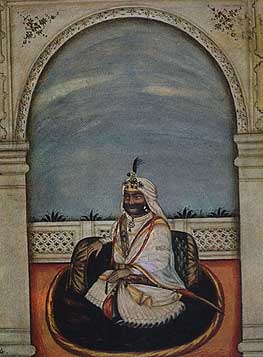
Sardar
Desa Singh of noble Majithia house died in 1832 and was succeeded in all of his
estates by his eldest son Lehna Singh who first served with credit in the Multan
Campaign of 1818 and soon became known for ability and learning.
He
was a skilful mechanist and an original inventor. He made improved Sikh ordnance
and some very beautiful guns manufactured by him were taken in the Satluj Campaign.
Amongst other things, he invented a clock, which showed the time, the day of the
month and the changes of the moon. He was fond of astronomy and mathematics and
was master of several languages.
As an administrator he was very
popular. The poor were never oppressed by him. His assessments were moderate and
his decisions were fast. As a statesman he may be said to have been the only honest
man in Lahore. Fraud and corruption were supreme, but the hands of Lehna Singh
were always clean: surrounded by the most unscrupulous schemers, he preserved
his honesty unsullied.
Had a man of reputation and administrative ability of
Lehna Singh Majithia taken the lead in 1845, the great trouble which came upon
his country might have been averted.
But he was no true patriot. He did not
understand that the religion of a statesman and indeed of every honest man is
to stand by his country in the time of danger, sharing her grief and if need be,
falling with herself.
Lehna Singh had one great fault, which shipwrecked all
of his virtues. He was timid and superstitious and was ever ready, at the approach
of danger, to move off to Hardwar to bathe, or to Banaras to feed a crowd of hungry
Brahmans. He did so just before the Satluj Campaign of 1845, and when the Panjab
Campaign of 1848 commenced, he left Governorship of Amritsar early in 1849. He
returned to Panjab in 1851, and after two years went to Banaras, where he died
on 25th July 1854.
Lehna Singh's brother Sardar Ranjodh Singh commanded the
Sikh army at the Battle of Baddowal on 21 st January 1846 and lost, through timidity,
a great chance of doing the British army a considerable damage. Later he was bitterly
defeated by Sir Harry Smith (at Aliwal on 28th January 1846).
There is a well-known
saying in the country to the effect that three families in Panjab viz. Atariwalas,
Mans and Majithias have possessed the greatest number of remarkable men. Atariwalas
are brave and fearless: Mans are handsome, gallant and true: Majithias are knave
and timid!
DIWAN SAWAN MALL
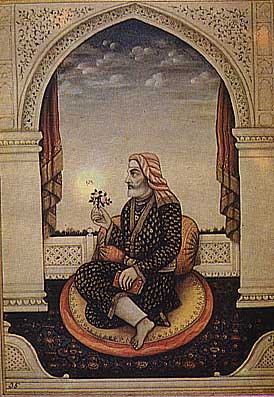
Diwan
Sawan Mall, whose ability was well known to Maharaja Ranjit Singh, was appointed
Governor of half of the province of Multan and in 1829, he was made Governor of
the whole of it.
The tract of the country, which then came under the rule of
Sawan Mall, was very extensive and comprised the districts of Multan, Dehra Ghazi
Khan, Laiya and part of Jhang. It was at that time almost a desert, having been
the scene of rapine and war for many years. Life and property were insecure and
population, which had once been numerous and wealthy, had become scanty and unfortunate.
But
under the new administration a great change was brought. By offers of land and
protection, Diwan Sawan Mall had induced many of the inhabitants of neighbouring
districts to settle in that province. In Multan District alone he excavated canals
to the length of three hundred miles. He fostered commerce and acted in every
way as a wise and beneficent ruler.
During the reign of the great Maharaja
Ranjit Singh, Sawan Mall was little disturbed. Ranjit Singh saw the gradual increase
of the Diwan's power, but he knew that during his reign he would not rebel, and
as the tribute was paid with the greatest regularity, there was no cause of complaint.
When
Raja Dhian Singh was assassinated by Sandhanwalias, Diwan Sawan Mall was deprived
of the most able of his friends.
During the preceding years, Diwan Sawan Mall
had been strengthening himself at Multan, and there is every reason to believe
that he intended, at some favourable opportunity, to throw off allegiance to Lahore,
and to declare his independence. It was with this intention that he expended so
much money and labour upon his fort at Multan, so that it was all but impregnable
to a native force.
On 16th September 1840, at his morning Durbar, a soldier
who had been caught thieving, was brought up before the Diwan for trial. After
inquiry, the prisoner was remanded and placed in antechamber, with a guard over
him. As the Diwan was holding court, the prisoner fired at him with a pistol.
The assassin was at once cut down, and Sawan Mall died a few days later.
Sawan
Mall was the best of all Sikh Governors.
During the later years of Maharaja
Ranjit Singh's life, and during those of his successors, the Diwan was practically
irresponsible, yet his great power was in no way abused (by him).
It is true
that he amassed great wealth but it was not wrongfully acquired from people by
cruelty and oppression.
It was a common saying in the country that Multan was
pleased with Sawan i.e. the Month of Rain and Laiya with Karam i.e. kindness while
Jhang was desolated by Mula which is an Insect which destroys corn. The allusion,
of course, was to Governor of Multan Sawan Mall; Karam Narain, his second son,
Kardar of Laiya; and Mul Raj, his eldest son, Kardar of Jhang.
DIWAN MUL RAJ MULTANWALA
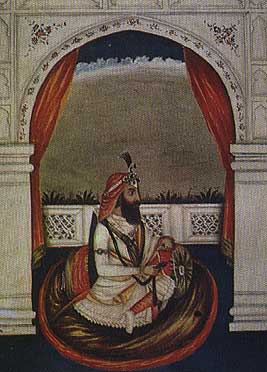
In
1840 Diwan Mul Raj succeeded his father Sawan Mall as Governor of Multan. He was
no great ruler. He had, in fact, declared that he was anxious to retire into private
life, since the difficulty of raising the revenue demanded by Lahore (Government)
was more than he was capable of coping with.
It must be understood that his
offer of resignation was purely voluntary, but there is no doubt that he thought
that his services could not be spared and a lower amount of revenue would be demanded.
His
resignation was, however, accepted, and Sardar Kahan Singh was appointed in his
place in cooperation with two English officers Vans Agnew and Lt. Anderson.
Agnew,
Anderson and Kahan Singh marched from Lahore with an escort of fourteen hundred
Sikh infantry, seven cavalry and a Gurkha battalion with six guns and encamped
in April 1848 at Idgah, half a mile from the Fort of Multan.
Next morning the
English officers and Kahan Singh, with some of their escort, accompanied Mul Raj
into the fort and discussed the arrangements (for transfer of charge of Governorship
from Mul Raj to Kahan Singh).
While they were on way back to Idgah, one of
the soldiers of Mul Raj, at the bridge over the ditch of the fort, struck and
wounded Vans Agnew. Evidently it was a signal for attack on the party (comprising
the English officers, Kahan Singh and their escort).
Mul Raj
rode off to his own residence whilst no sooner was Anderson attacked than the
Gorkha escort rescued him: Kahan Singh rescued Vans Agnew, putting him on his
own elephant. Both officers were brought into their own encampment where their
wounds were dressed.
Agnew immediately despatched a report to the Resident
at Lahore and sent off a message to Lt. Herbert Edwardes and to General Cortlandt,
an officer of the Sikh service at Bannu.
In the meantime, at Multan itself,
Mul Raj sent his emissaries to Idgah to inform Agnew that his people would not
allow him to resign, and that he could give the Englishmen no help: at the same
time he ordered (the Englishmen's) escort to desert to him and to place himself
at the head of revolt.
In the evening some of the soldiers and the town rabble
mobbed the Idgah, took Kahan Singh prisoner and murdered the two English officers.
The
die was cast!
All troops joined Mul Raj who forthwith proceeded to strengthen
the fort and obtain further troops.
The gallant Edwardes took the initiative
and as he knew that the Sikh troops in Derajat were not to be trusted, he called
on the Pathan Chief of the district to rally round him against Sikhs whom the
said Chief hated. This kept the Khalsa troops quiet.
Edwardes' first object
was to prevent Mul Raj from sending any force to Derajat to get the Sikh troops
there to join him.
At that time Edwardes was at Dera Fateh Khan with his Pathan
levies.
On 16th May 1848, three hundred men whom Edwardes had stationed at
Laia, across the Indus, attacked and defeated four hundred men sent by Mul Raj.
Edwardes
had just written to the Resident at Lahore, that if the Chief of Bahawalpur would
cross the Satluj and move up the River Chanab, he would be able to join him, and
that together they might drive out Mul Raj.
Later on, the Baloch Chief of Khosa
turned the Sikhs out of Mangrota and Dera Ghazi Khan and enabled Edwardes and
Cortlandt to cross the Indus on 10th June 1848 and to advance tojoin the Bahawalpur
troops, who had crossed the Satluj, and were advancing up the right bank of the
Chanab.
On 18th June 1848, Edwardes managed to cross the Chanab, while the
Bahawalpur troops were attacked by eight thousand Sikhs at Kaneri, and Edwardes
and Cortlandt arrived most opportunely to win the victory.
On 1 st July 1848
another pitched battle was fought and won at Suddusam.
After this, the (British)
troops took up a strong position at Surajkund, which they entrenched.
On 5th
July 1848, much to Edwardes' annoyance and anger due to delayed arrival of Raja
Sher Singh Atariwala, the latter joined the former with some five thousand troops
from Lahore.
For two months, these Muhammedan and Sikh forces, though mutually
hating each other, kept the enemy in check till the arrival of the British troops
under General Whish.
On 4th September 1848, Edwardes was also joined by General
Cureton with six guns and twelve hundred men. He fought throughout the Campaign.
Battling
broke out first at Jehlam.
The (British) Resident at Lahore proposed that the
force of British regiments, with siege guns, should move against Multan. The Commander-in-Chief,
Lord Gough, observed that he had not sufficient troops at hand in the event of
the outbreak spreading throughout the Panjab and that it would be difficult to
collect the necessary troops in the hot weather, and that at that time of the
year it was not desirable to despatch British troops (who were sensitive to summer
heat).
It is true that the Sikh Durbar proceeded to put down the revolted Governor
with their own General Whish's force consisting of seven thousand regulars of
all arms, Lt. Edwardes' seven thousand infantry and five thousand cavalry and
Sher Singh's six thousand soldiers of all arms with thirty-two siege guns and
one hundred and sixty-one field guns.
On 6th September 1848 the united force
moved forward close to Multan where there was severe fighting. General Whish's
two columns stormed and captured the two positions held by the enemy.
The result
was thirty-one killed and two hundred wounded (on our side). The enemy left five
hundred dead on the ground.
Notwithstanding our success, on the morning of
14th September 1848 Sher Singh and his troops went over to the enemy.
After
this desertion, General Whish felt that he was not strong enough to take Multan
until he was reinforced. On 16th September 1848, the army returned to Surajkund
where it was reinforced towards the end of December 1848.
In the meanwhile,
on 9th October 1848, Raja Sher Singh left Multan to join (his father) Sardar Chatar
Singh Atariwala who was at that time north of the Jehlam.
The Bombay force,
when it arrived, added to the British army five thousand and five hundred men,
thirty siege guns and thirty field guns.
On 27th October 1848 the British force,
in three columns, marched forward in a semi-circle, from south-west to north-east,
driving the enemy back.
The operation was thoroughly successful.
During
the following three days and nights breaching batteries opened fire on the Khuni
Burj and the Delhi Gate (in Multan).
On the 30 October 1848, large magazine
on the South Gate of the fort was blown up. The explosion was of so terrific character
that it silenced the entire siege: every man in the force had to pause and take
breath after so tremendous a surprise.
The whole earth shook for miles round
the fort and the atmosphere was darkened for hours by a dense cloud which hung
like a mantle over the city. The scenes of carnage presented within the town after
the explosion are said to have been fearful. The principal houses and temples
were destroyed totally or partially, and it was ascertained that two hundred human
beings were instantaneously killed besides a vast number wounded through the falling
houses and fragmants.
On 2nd January 1849, the breaches having been reported
practicable, the Bengal Column was ordered to assault Delhi Gate and the Bombay
Column (was directed to attack) the Khuni Burj. The Native Column headed by the
Bombay Fusiliers, after a score of gallant struggle, caused the breaches, and
the Bengal Column,finding their trench utterly impragnable, turned to the left
and volleyed over the Khuni Burj. There was desperately hard fighting for both
columns, but by evening the town was entirely in our possession.
The enemy
fought bravely.
The greatest struggle occurred round the Khuni Burj where the
slaughter was heaviest.
The city fell, but the fort remained in the hands of
Mul Raj who seeing the success of the besiegers, closed its gates, so splitting
out those Sikhs who tried to hold the city, while keeping back with him in the
fort four thousand picked men.
Fresh batteries were erected on both sides of
the fort, and terrific cannonade was maintained for fifteen days.
But on 22nd
January 1849, Mul Raj surrendered at discretion.
He was taken to Lahore, charged
with complicity in the murder of Vans Agnew and Anderson and found guilty.
Amid
excruciating circumstances, he spent in confinement the remainder of his life,
which was prolonged only for a short time.
During the siege, we lost one thousand,
one hundred and fifty-three killed or wounded, while thirteen officers died and
fifty-one were wounded.
DIWAN AYUDHIA PARSHAD
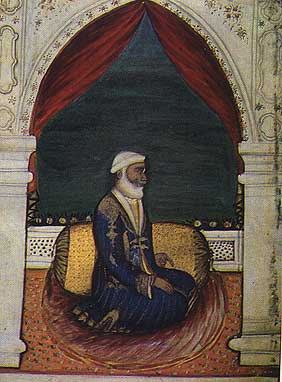
His
probity was well-known, his learning was considerable and he was ever ready to
assist in the improvement and establishment of (Lahore) City.
The brother of
Dina Nath, Diwan Ayudhia Parshad, was summoned to Lahore by his father Diwan Ganga
Ram, and received, through his interest, in 1820, the Paymastership of Fauj Khas
or Special Brigade under General Ventura, an Italian, consisting of four Regiments
of infantry and two Regiments of Cavalry.
On the death of his father, he was
created Diwan. He continued to serve with Fauj Khas and when General Ventura was
absent on leave in Europe, he commanded the whole force. So ably did he do this
that General Ventura wrote of him in these terms: "On the two occasions,
when I have been absent in Europe, Ayudhia Parshad has held the command of the
Life Guards of Maharaja. On my return from Europe, I have found the troops in
as good condition as if I had been present myself."
In 1830, Ayudhia Parshad
was sent to Multan to meet Lt. (Alexander) Bumes, who brought, from the King of
England, a present of cart horses and a carriage for Maharaja Ranjit Singh.
Ayudhia
Parshad saw much service in the field in Fauj Khas.
When at the end of 1843,
General Ventura, disgusted with the misfeasance of the troops, and clearly foreseeing
the problems coming on the country, finally left the Panjab, Diwan Ayudhia Parshad
wa: appointed to the command of the Brigade, which he held till the close of Satluj
Campaign.
When he tendered his resignation, which was accepted,
he left the corps with which he had seen service for nearly six years.
In April
1849, the Diwan was appointed to take charge of the young Maharaja, Dalip Singh,
in conjunction with Dr. Logan. He accompanied the Prince to Fatehgarh, when he
remained in attendance upon him till September 1851. Then, the Maharaja being
about to leave for England, he returned to Panjab, and gave up public life.
Dr.
Logan has given the highest testimony to the Diwan for upright and honourable
conduct while with the Maharaja at Fatehgarh.
After the treaty of 1846, making
over the hill country between the Ravi and the Indus to Maharaja Gulab Singh,
Ayudhia Parshad was appointed Commissioner in conjunction with Captain Abbott
to mark the boundary line of Lahore and Jammu territories. The work, which was
by no means easy, occupied two years till 1848.
During all this time, his conduct
gave greatest satisfaction to the authorities, and he showed greatest courtesy
and attention to the British Commissioner Captain Abbott, later General Sir James
Abbott, who was the famous traveller in Central Asia, who released several hundred
Russian prisoners at Khiva before the Afghan Campaign in 1839, and also in 1845,
in Hazara, opposed Sardar Chatar Singh Atariwala with levies of Pathans in that
district: in late years the station Abbotabad was named after Abbott.
In 1862
Ayudhia Parshad was appointed Honorary Magistrate of Lahore City and in this position
he gave satifaction (to his superiors).
His probity was well-known, his learning
was considerable and he was ever ready to assist in the improvement and establishment
of (Lahore) City.
Ayudhia Parshad was much liked and respected by the British
officers who knew him at Lahore.
DIWAN KIDAR NATH
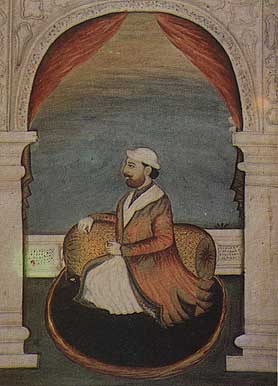
Diwan Kidar Nath (above)was Diwan Dina Nath's brother.
For many years he was a servant of Lahore State.
He received the title of Diwan from Maharaja Dalip Singh.
On the (British) annexation of Panjab, he received from the British Government a life pension of Rs. 6000/-.
He died in 1859.
Pandit Jalla
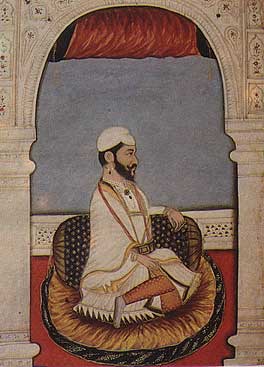
Pandit
Jalla, a Brahman, was a man of most repulsive character and of a most tyrannical
and ambitious spirit. Pandit Jalla had been tutor to Raja Hira Singh in his youth.
No sooner was Hira Singh in power than his actions, owing to influence of Jalla,
caused much dissatisfaction.
The leading spirit amongst the malcontents was
Sardar Jawahar Singh. Early in March 1844, he and his sister Maharani Jindan sent
an invitation to Raja Suchet Singh to come to Lahore, promising that the army
would welcome him, and (conjecturing) that he could supplant Hira Singh as Vizier.
In an evil moment for himself, the gallant Suchet Singh started, and with a small
force reached the neighbourhood of Lahore.
Pandit Jalla knew that the success
of Suchet Singh would, for private reasons, mean death to himself, and so he persuaded
Hira Singh to promise pay raise to the army. This would, for the moment, make
Hira Singh very popular, and as the Pandit feared that Hira Singh might come to
an understanding with the Pandit's enemy (Suchet Singh), he prophesied to Hira
Singh that he would be murdered and produced a horoscope in which it was foretold
that Hira Singh or Suchet Singh would fall the next day. (To avert mortal danger
to him,) Hira Singh then ordered the army to advance and killed Suchet Singh and
his small force.
Still the hatred towards Pandit Jalla rapidly increased. Repeated
demands were addressed to Raja Hira Singh to part with Jalla, but the Raja refused
to comply and so turned the influence of army against him. Hira Singh and Jalla
fled with some followers and the running fight of some miles ensued in which they
and most of their followers were slain. The heads of Hira Singh and Pandit Jalla
were paraded through the streets of Lahore.
PANDIT
MADHUSUDAN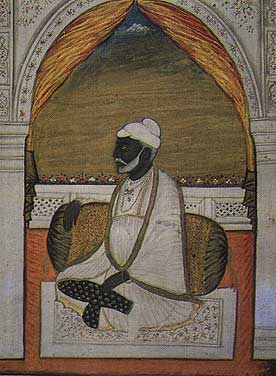
Pandit
Madhusudan was a great scholar, and there was no other Pandit in Lahore who had
so extensive an acquaintance with Sanskrit literature.
In 1808, Madhusudan
was appointed a Muharar (or Amanuensis) to the Maharaja, and (also) Chief Durbar
Pandit, both of which offices he held till Annexation.
He was a favouri'.e
of Maharaja Ranjit Singh, who, in 1824 appointed his son Radha Kishan, a Tutor
to the young Raja Hira Singh whose (later) life, mean, sensual and untrue, did
not certainly say much for his education.
Pandit Madhusudan died in 1863.
JAMADAR KHUSHAL SINGH
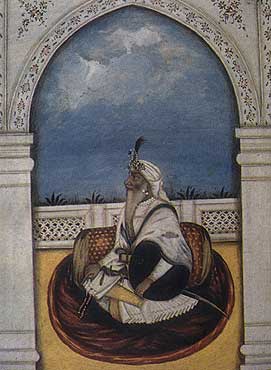
One
of the most conspicuous figures at Maharaja Ranjit Singh's court was Jamadar Khushal
Singh. He was the son of a Brahman shopkeeper in Meerut Division. At the age of
seventeen, he came to Lahore to seek his fortune, and was taken into a regiment
on five rupees a month.
He soon made friendship with the Maharaja's Chamberlain
and was placed on the personal guard of Ranjit Singh. Here, by his vigilance,
aided by his good looks and soldierly daring, he attracted the favourable notice
of Maharaja.
The story told by his family is to the effect, that one night
Ranjit Singh went out in disguise, and on his rerun to the palace was stopped
by Khushal, who was on guard, and he detained his Master in the watch house till
morning. The vigilance pleased the Maharaja so much, that he kept Khushal by him
as a personal attendant.
However this may be, it is certain, that he rose daily
in his Master's good favour till in 1811 he was appointed Chamberlain with the
title of Jamadar. The appointment was one of importance. The Chamberlain was master
of ceremonies, regulated the processions and superintended the Durbar. It was
through him alone that any individual, however high his rank, could obtain a private
interview with the Maharaja, although the daily Durbar was open to all men of
(royal) family and official importance.
Five years after Khushal arrived at
Lahore, he was baptized as a Sikh, and after this grew rapidly in favour. He soon
became very wealthy, as he used his influence with his Master to obtain bribes
and contributions from all attending the court.
He was employed on various
military duties, and in 1832 was appointed Governor of Kashmir, under Prince Sher
Singh, when the (governmental) oppression converted a year of severity into one
of famine.
Khushal Singh was not a man of ability and although the Maharaja
was attracted by his good looks in the first instance, the accompanying portrait
taken late in his life shows him a course, vulgar man far inferior to the handsome
Sikh soldiers. He was unpopular at court, and showed himself something of a tyrant.
Jamadar
Khushal Singh died in 1844, having missed not little in the policies during the
last three years of his life.
COLONEL
DHAUNKAL SINGH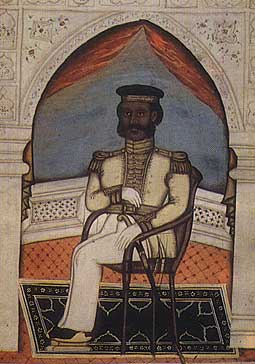
In
the early part of Ranjit Singh's career, there was no such thing as money payment
for the army, but (there was) soldiers record instead. It was considered ignoble
to take money payment, and a money soldier was held in contempt.
It was in
1809, when Mr. Metcalfe was deputed to Amritsar that Ranjit Singh first set his
mind upon disciplined and regular soldiers. It so happened that an attack was
made on Metcalfe's escort by some of undoubted Akalis, who though much outnumbered
the sepoys, were boldly beat off. Ranjit Singh was not too slow to leave the lesson
taught, and he looked about to find any one, who could instruct his troops in
drill. Dhaunkal Singh appealed to the Maharaja that he knew the bayonet exercise,
and he was immediately employed.
The old troops took umbrage and resisted the
innovation and the idea of money payment too proved uninviting.
Ranjit Singh,
who was not the man to be turned aside from his purpose, just gave purses and
presents, with his own hands, to each of those who learned (the new art). The
sight of money was, too, made for the remainder of the army, who, (with passage
of time) no longer held aloof from the new discipline and regular payment.
Ranjit
Singh attempted as a further innovation to introduce the sepoy's cap instead of
turban. This the army would not stand but mutinied. The wise Maharaja bided his
time, and told the Sikhs that he would never enforce caps on his own faith and
nation. Shortly afterwards when a regiment of Gorkhas were to receive their pay,he
ordered three battalions of Sikhs to surround them, and secure a promise from
them that they would wear caps. On Gorkhas having received pay, the three Sikh
battalions marched down on them as they had been forewarned. Gorkhas halted and
cried: "Let us pass or we open fire. You would not wear the caps." Upon
this the Sikhs ran up and embraced the Gorkhas and a great fraternization followed.
Still Ranjit Singh, though obliged to overlook these acts, did not swerve from
his puropse and he managed to effect his end adroitly by ordering the Drill Instructor
Dhaunkal Singh to wear a cap himself and to enlist only such men as recruits who
were willing to promise to wear the cap. Dhaunkal Singh managed to do so and,
by degrees, cap became accepted in the army and Dhaunkal Singh became a Colonel.
FAQUIR IMAM-UD-DIN
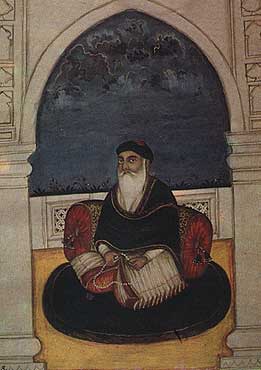
Faquir
Imam-ud-Din played a subordinate part to his brother Faquir Aziz-ud-Din.
During
the quarter portion of Ranjit Singh's reign, Imam-ud-Din was the custodian of
the celebrated Fortress Gobind Garh at Amritsar and the Governor of the country
immediately surrounding it.
He led the force sent to reduce the fort of Mai
Sada Kaur at Kalanaur and also served in one or two other campaigns.
Imam-ud-Din
died in 1844.
AKALI
NATHA SINGH
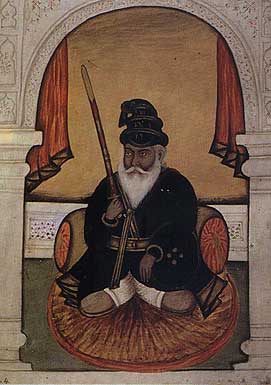
(McQueen
has not given any detail about Akali Natha Singh.)
— Editor
NIHANG
PHOOLA SINGH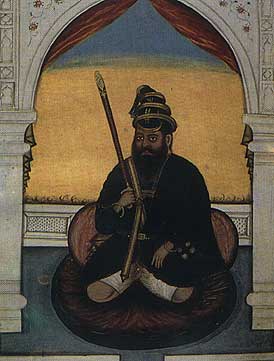
Nihang
Phoola Singh, an Akali of the Jat caste, first distinguished himself as the leader
of the attack on Metcalfe's escort in 1809 at Amritsar.
Soon after the successful
termination of this exploit, he and some of his comrades forced themselves into
the presence of Ranjit Singh and, in a very turbulent manner, demanded the slaughter
of the British Guards, and his return after a long interview with Maharaja, induced
the young Akali and his followers to lay aside their desire for British blood,
and Maharaja dismissed them with presents and sent them away in good houses.
As
an acknowledged Chief of Akalis, Phoola Singh served the country as a freebooter,
but he was noted as much for his kindness and forbearance towards the poor, as
for his ravages upon the rich.
The fame of Phoola Singh's exploits soon reached
the ears of Ranjit Singh who, however, did not proceed to extremities, but generally
remonstrated with him on his conduct, gave him presents and persuaded him and
his followers to take service with him, without insisting on the enforcement of
regular military discipline. Thus it happened that in most of the battles which
Ranjit Singh fought with his Afghan foes, the tide of battle was turned in his
favour by the daring and impetuous onslaught of some of these desperate spirits.
On
many occasions, as at Multan and in Kashmir, Phoola Singh displayed great daring,
but here we have space only to relate his gallant death in the battle of (Tibba)
Teeree in the Peshawar valley in 1823. At first victory appeared declared against
the Sikhs. They had been repulsed in several attacks and were beginning to retire
from field, when Ranjit Singh, to his great surprise, saw the black banner of
Phoola Singh and five hundred Akalis moving to the attack. Ranjit Singh had himself
seen Phoola Singh struck down from his horse by a musket-ball which shattered
his knee-cap: he was borne to the rear, utterly disabled, but there Phoola Singh
was seated on an elephant, actually leading his little band to the assault.
The
Afghans waited not for the attack, but rushed down the hill to become the assailants.
The Akalis dismounted from their horses, shouting their war-cry Wahiguru ji ki
Fateh while the Afghans (uttered) their cry Allah, Allah! The horses set at liberty
returned from battle or, alarmed by the tumult, rushed forward wildly into the
ranks of the enemy and caused confusion among the Aghans. The Akalis followed
to the attack sword in hand: (in the meanwhile) Phoola Singh received a second
bullet wound, and his mahout, who had already received three wounds, became terrified
and hesitated to advance. Phoola Singh drew the pistol and shot the man through
the head and, with the point of his sword urged the elephant towards the enemy.
He had not, however, advanced much further, when another bullet entered his forehead
and he fell back dead. The death of their leader so infuriated the Akalis, who
were now barely one hundred and fifty strong, that their desperate resolution
carried the assault, and in the end made a way for the best of the fighters of
Sikh army into the midst of the enemy's position, and dislodged the Pathans from
their strong post with great slaughter.
The heroism of the Akali chief elicited
the applause of both Sikhs and Pathans, and the tomb erected over his ashes, although
watched and tended by Akalis, has become a place of pilgrimage for the Sikhs,
Hindus and Muhammedans alike. He was cremated on the spot where he fell. The tomb
stands opposite the cantonment of Noshehra on the bank of River Kabul.
SHAIKH
GHULAM MUHAIY-UD-DIN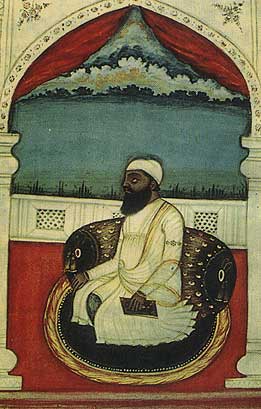
Shaikh
Ghulam Muhaiy-ud-Din, when very young, attracted the attention of the celebrated
General Diwan Muhkam Chand's son, Moti Ram, who placed the Shaikh in attendance
on his second son Shiv Dial whose two brothers, Ram Dial and Kirpa Ram, also favoured
the young man and advanced his interests.
In 1827 Shaikh Ghulam Muhaiy-ud-Din
accompanied his patron Kirpa Ram to Kashmir, where the latter had been appointed
Governor. The Shaikh became the Sole Agent for Kirpa Ram, and he exercised his
power with great cruelty and tyranny.
In 1831, through the ruses of Raja Dhian
Singh, Kirpa Ram was recalled (from Kashmir). Ghulam Muhaiy-ud-Din was also summoned
to Lahore where he was fined and imprisoned. But later in the same year he again
proceeded to Kashmir as Agent for Prince Sher Singh, who had been nominated to
succeed Kirpa Ram. The Shaikh was again called back to Lahore and fined. He remained
out of employment till Sher Singh ascended the throne.
When the news of the
murder of General Mian Singh, Governor of Kashmir, reached Sher Singh, Shaikh
Muhaiy-ud-Din was appointed to succeed him. The Muhammedan troops had revolted,
the hill Rajas were all up in arms and the Sikhs found that they had to make their
most difficult conquest over again.
In the meantime Kashmir had been entirely
overrun by the insurgents, and Ghulam Muhaiy-ud-Din became shut in the fort of
Hari Parbat.
The force of Gulab Singh Pahuvindia at length advanced into the
valley, and after some hard fighting the insurgents were defeated.
In February
1845 Shaikh Ghulam Muhaiy-ud-Din tried to open negotiations with the English government
to which he tendered his allegiance. His proposals were rejected, and soon afterwards
he died, it is believed, from poison, and his son Imam-ud-Din Khan, who was in
Kashmir at that time, succeeded him as Governor.
IMAM-UD-DlN
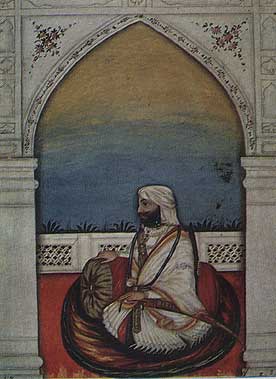
Imam-ud-Din
was Governor of Kashmir, when the province was made over to Maharaja Gulab Singh
by the treaty of 16th March 1846.
This transfer was not popular at Lahore,
and to the Prime Minsiter Raja Lal Singh, it was particularly distasteful, for
Gulab Singh had always been his rival and enemy. He clandestinely sent instructions
to Imam-ud-Din to (disregard offical orders and to) oppose Maharaja Gulab Singh,
and instructed the troops to obey the Governor implicitly. Imam-ud-Din was very
sick (at the new development), and he understood that the success of Maharaja
Gulab Singh signified not only the end of his exaction but also the rigid execution
of his accounts by his declared enemies.
It is possible that Imam-ud-Din, misunderstanding
the motive of the British government, imagined that by the payment of a large
sum of ready money, he might be allowed to retake Kashmir as Viceroy (under the
British government of India), and with this object he was ready to carry out the
instructions of Raja Lal Singh. He made a prolonged resistance, showing his own
power and resources. But, irrespective of the reason of his conduct, he disregarded
the peremptory (official) orders of the Lahore Durbar to evacuate the province.
It was not until the army had reached the border of Kashmir valley, that Imam-ud-Din,
seeing further opposition useless, came to Colonel Henry Lawrence's camp at Thana
and surrendered himself. (To Lawrence) he gave two letters and (content) of his
address to the troops serving under him, in obedience to which he had acted (towards
resisting surrender of Kashmir to Gulab Singh). The authenticity of both letters
and the address were fully proved, and Lal Singh was convicted of deliberate treason,
was deposedfrom Prime Ministership, and banished to Agra. Imam-ud-Din, though
a willing party to treason, was, (however,) pardoned, and his Lahore estates,
which with his other property in that city, had been confiscated, were restored
to him.
The government's aforesaid treatment seems to have made a favourable
impression on Imam-ud-Din (so that) in 1848, when almost all were traitors to
the (British Indian) government, he remained faithful, though great efforts were
made by the leaders of the rebellion to gain him to their side. In June 1848,
with two thousand newly raised troops, he marched to Multan to cooperate with
the force of Lt. (now Sir) Herbert Edwardes. Both he and his men rallied well
and distinguished themselves in several actions with the rebels.
When peace
was restored, Imam-ud-Din received, as a reward for his services, the title ofAman-ul-Ummat,
and a cash pension of Rs. 11,600 for life and a jagir of (annual income of) Rs.
8,400 were conferred on him.
In 1857 he raised, under the order of Government
two troops of cavalry for service at Delhi.
He died in March 1859.
NAWAB
MUZAFFAR KHAN MULTANI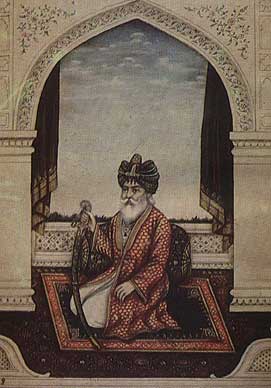
When
Taimur Shah, King of Kabul, marched to Multan in 1779 with a large army, and recovered
it from the Sikhs after a siege of forty days, he appointed Muzaffar Khan, a Saddozai,
as Governor with the title of Nemat. Muzaffar Khan's precedessors had settled
here for some five generations, and he was the fourth Governor in the family with
the title o Nemat.
The new Governor was an an energetic and able man and improved
the province during his long reign. He had not, however, much time to bestow on
works of peace till his death in 1818, for he was engaged in constant war with
the Sikhs and his Muhammedan neighbours. In 1802,1806 and 1807 Ranjit Singh came
down against Multan, and Muzaffar Khan escaped on these occasions only by paying
large exaction, and on the last occasion the town was nearly captured. In 1807,
Muzaffar Khan, tired of constant war, made over the Governorship to his eldest
son Sar Afraz, and set out on a pilgrimage to Mecca.
He returned about the
close of 1808 and soon after this Elphistone visited Multan on his way to the
court of Shah Shuja at Peshawar. (At Multan) he was hospitably received, and extended
dawat that he may be placed under British protection, but the British envoy had
no authority to accept his allegiance, and Muzaffar Khan then opened correspondence
with the Governor General at Calcutta, expressing his desire to be on good terms
with the English.
In 1810, Diwan Muhkam Chand, the great Sikh General, was
employed to take Multan. Ranjit Singh was himself present, but to his utter disgust,
the attack failed, and the Maharaja had to retire from Multan after receiving
the sum of thirty thousand rupees from Muzaffar Khan.
In February 1816, Multan
was again besieged, and in a sudden assault, Akali Phoola Singh, drunk and maddened
with hemp, led a storming party of fanatics like himself and captured the outworks
of the Citadel.
In 1818 Ranjit Singh sent, under Misar Diwan Chand an army
of 25,000 men against Multan. The Nawab had a garrison of only 2,000 men and the
Citadel was not provided for a siege: but he made a defence, the like of which
the Sikhs had never seen before.
The siege commenced in February. The Sikhs
made assaults, but they were repulsed on one occasion with the loss of 1800 men.
The gates were blown up, but the garrison rebutted them, throwing up mounds of
earth on which they fought hand to hand with the Sikhs. The defenders were reduced
to some 300 men, most of them of the tribe of Muzaffar Khan, the rest having been
either killed or gone over to the enemy.
At length, on June 2, an Akali by
the name of Sadhu Singh, determined to surpass the feat of Phoola Singh in 1816,
rushed with a few desperate followers into an outwork of the fort, and taking
the Afghans by surprise, captured it.
The Sikh forces, seeing this success,
advanced the assaults, and mounted the breach at the Khan Garh Gate.
The old
Nawab with his eight sons, and all who reamined on the garrison, stood swords
in hand, resolved to fight to death. So many fell beneath the Afghan swords that
the Sikhs drew back and opened fire on the little party with their match-locks.
"Come
on like men," shouted the Afghans, "and let us fall in fair fight,"
and this was the invitation the Sikhs did not care to accept. There died the white-bearded
Muzaffar Khan, scorning to accept quarter, and there died his five sons. His second
son was severely wounded and two others were taken prisoners. Diwan Ram Dial took
the eldest Sar Afraz Khan upon his elephant and conducted him with all honour
to his own tent.
Few of the garrison escaped with their lives and the whole
city was given over to plunder.
Multan remained in the hands of Sikhs upto
22nd January 1849 when it was taken by the British.
SARDAR
YAR MUHAMMAD KHAN
Sardar Fateh Khan, Chief
of the Barakzais, was a man of great importance, and, in fact, acted the part
of a King-Maker under the three Amirs, to whom he was Vizier.
Fateh Khan was
suddenly seized by Prince Kamran and some Afghan chiefs, who blinded him and tortured
him to death by slowly hacking off his limbs.
For many years, Fateh Khan had
placed one of his eleven half-brothers in the chief positions in the cities of
Kabul, Qandharand Peshawar. When the news of the brutal murder of Fateh Khan came,
the Afghans rose and forced (Shah) Mahmud and his son Kamran to flee to Herat.
The late Fateh Khan's brother at Kabul, Azim Khan, assumed the nominal rule, and
was succeeded after his death by the well-known Dost Muhammad Khan.
The four
brothers at Peshwar, Yar Muhammad Khan, Sultan Muhammad Khan, Sa'id Muhammad Khan
and Pir Muhammad Khan, some of them born of one mother, ruled portion of the districts
of Peshawar and Kohat. They obeyed the Kabul ruler to a certain extent, and afterward
(they subordinated themselves to) Ranjit Singh, when he conquered Peshawar. Yar
Muhammad Khan retained his title as Governor. For many years the Barakzai brothers
dividedtheir allegiance between Kabul and Lahore, (posing loyalty to whichever
party had the upper hand at the time). There was constant fighting between the
Afghans and the Sikhs, but as a rule, the party in power received their revenue
from the local Governor. As an instance of Ranjit Singh's unscrupulous methods
for tenacity of purpose, the following story is typical.
Maharaja Ranjit Singh
ordered Yar Muhammad Khan to present him with a famous mare called Laili, and
when the latter declined to do so, the Maharaja sent an army under General Budh
Singh to seize her, but when the General reached Peshawar, he was informed that
Laili was dead.
On Budh Singh's return to Lahore, it was ascertained that this
story was false, and another force under Prince Kharak Singh was sent up to bring
the mare or to replace Yar Muhammad Khan if he refused to part with her. Considering
that his honour was involved, Yar Muhammad Khan fled to the hills, with the men
surrounding the mare. On 8th March 1827 Kharak Singh retired from Peshawar, leaving
Sultan Muhammad Khan as Governor, but Yar Muhammad returned, and drove out his
brother before the Sikh army had reached Attock.
After this, General Ventura
was sent up with a fresh expedition to obtain the mare, and while Yar Muhammad
Khan was hesitating as to his reply, Khalifa Sayyad Ahmad (Barelvi) descended
from the hills and managed the villages north of Peshawar, and Yar Muhammad Khan
was killed in the fighting which ensued. General Ventura then defeated Sayyad
Ahmad (Barelvi), and encamping before Peshawar demanded the animal from Sultan
Muhammad Khan, but the latter tried subterfuge as his brother (had earlier done),
and it was not until he was taken prisoner by General Ventura, that the mare was
handed over to the Sikhs.
Maharaja Ranjit Singh acknowledged in later years
that Laili had cost him 12,000 men and sixty lakhs of rupees, but there is a suspicion
that he was outwitted by the Afghan, and (it is doubtful whether), after all,
he got possession of the original mare. Certain it is that no horse in the history
has ever been the cause of so much trouble and the death of so many brave men.
COMMENTS
The powerful Chief of the Barakzai clan Payandah
Khan had twenty-one sons from eight wives. Out of them Yar Muhammad Khan had four
full brothers, namely, Ata Muhammad Khan, Sultan Muhammad Khan, Sa'id Muhammad
Khan and Pir Muhammad Khan. Dost Muhammad Khan had one full brother named Amir
Muhammad Khan. Fateh Khan had two full brothers named Taimur Quli Khan and Muhammad
Azim Khan. In 1800 Shah Mahmud seized his half-brother Shah Zaman's throne with
the help of Payandah Khan's eldest son Fateh Khan.
SARDAR
SULTAN MUHAMMAD KHAN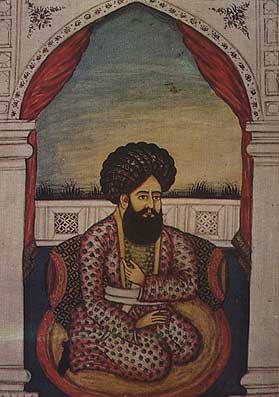
Sardar
Sutlan Muhammad Khan was a brother of Sardar Yar Muhammad Khan of whom an account
is given in the preceding pages. He was a half-brother of Amir Dost Muhammad Khan
of Kabul, and there was no one of his race and family more noted for treachery
and intrigue than he.
After the Sikh army under Kharak Singh had driven back
Yar Muhammad Khan out of Peshawar, they retained Sultan Muhammad Khan as Governor.
On hearing this, Yar Muhammad Khan returned and displaced his brother.
About
three years later, (the soldiery of Khalifa) Sayyad Ahmad (Barelvi) killed Yar
Muhammad Khan. Barelvi captured Peshawar which he managed to hold for a year whereafter
General Ventura arrived with a Sikh army to take possession of it.
Sardar Sultan
Muhammad Khan having given up (to Ranjit Singh) his late brother's famous Laili,
he was appointed Governor of Peshawar a second time, on which (development) the
Sikh army retired from (Peshawar) valley.
In 1838, Sultan Muhammad Khan was
found intriguing with Afghans, and the Sikhs being now much stronger in cis-Indus
area, they crossed that river into the (Peshawar) valley, deported Sultan Muhammad
Khan to Lahore, and deprived him of \\\sjagir and private estates. He was kept
a prisoner at Lahore until the end of the Satluj Campaign of 1846, when at the
suggestion of the British Agent Major Henry Lawrence, the Sikh Durbar had him
releasedand had his private estates restored to him in order that he might be
able to give assistance to George Lawrence, who was the British Officer (stationed)
at Peshawar to look after the Sikh Governor and the Sikh troops there.
After
the Outbreak at Multan in 1848, Sardar Chatar Singh, commanding the Sikh troops
in Hazara, raised the standard of revolt (against the British), and moved part
of his troops to Peshawar to get the soldiers there to join him, when it was intended
to make over the whole of the Peshawar valley to Amir Dost Muhammad Khan (as an
inducement to elicit his support against the British).
On 31st October 1848,
the Sikh troops at Peshawar mutinied (against the British), and Major George Lawrence
and Lt. Bowrie, with the greatest difficulty, escaped to Herat, where they joined
Mrs. Lawrence and family, who were living in Sultan Muhammad Khan's home there.
Previous to the departure of Mrs. George Lawrence and her children (to Herat),
Sutlan Muhammad Khan had sworn on the Quran, in the most solemn manner, to provide
for the safety of Major George Lawrence, his wife and the British officers attached
to the Residency, but on Sardar Chatar Singh's arrival at Peshawar, the treacherous
Sultan Muhammad Khan ordered his son, who was the Governor of Kohat, to bring
Lawrence and his party back to Peshawar, where he handed them over to Chatar Singh.
From Peshawar, they marched with Sikh troops, were (apparently) treated well,
and given up at Rawalpindi to the Sikhs who murdered them shortly after the Battle
of Gujrat.
Lord Dalhousie's only condition of peace was the immediate surrender
of the Sikh army, who were to return to their homes after having given up their
arms. The only person who escaped as per Governor General's proclamation was Sardar
Sultan Muhammad Khan, whose base treachery in giving up Major George Lawrence
and his party to the Sikhs elicited Governor General's remarks that he considered
him unworthy of mercy. Before the British army could arrive at Peshawar, Sultan
Muhammad Khan fled to Kabul, where he died some years afterward, having been deprived
of all his land and private property at Peshawar.
NAWAB
SAR AFRAZ KHAN MULTANI
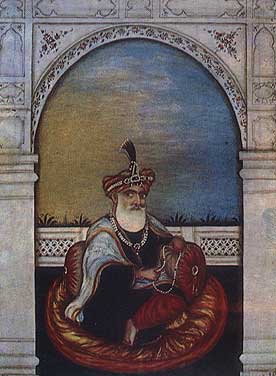
Nawab
Sar Afraz Khan was the eldest son of the gallant old Nawab Muzaffar Khan who died,
with five of his eight sons, at the taking of Multan.
Sar Afraz Khan was carried
prisoner to Lahore by Diwan Chand and was well received by Maharaja (Ranjit Singh)
who gave him a jagir at Sharakpur and Naulakha, afterwards commuted by the British
Government for a pension.
At first Sar Afraz Khan was rigorously guarded at
Lahore, and when the Maharaja's position was secure at Multan, he was allowed
perfect liberty and was always addressed by Ranjit Singh with respect and friendship.
In
1848 no influence was useful to the British Government in inducing the Multani
Pathans to abandon the cause of Mul Raj, which, however, they did not need much
pressing to do.
At the (time of) Annexation the Nawab had a JAGIR and a large
pension granted him.
Sar Afraz Khan died on 12th March 1851.
NAWAB
SA'ID MUHAMMAD KHAN
Nawab Sa'id Muhammad Khan
was the third (in order of seniority of age) among the four Barakzai brothers,
all of whom bore the title Sardar: the two eldest ruled in the Peshawar valley
at different periods.
Nawab Sa'id Muhammad Khan, for years, held charge of
District Hashtnagar of which he collected the revenue, and remitted the same to
the Afghan Governor of Peshawar i.e. one of his eldest brothers or to the Sikh
Governor after them.
Sa'id Muhammad Khan ruled as Magistrate in District Hashtnagar,
and kept order with his guards and posts on the Isapur border, and on the lower
border of Herat and on the post of Momand border.
Sa'id Muhammad Khan was an
innocent man and (was) utterly without ambition, but he was a brave man, who was
present in many a border fight and in several engagements with the Sikhs.
When
Sayyad Ahmad (Barelvi) defeated and killed his brother Yar Muhammad Khan at Isapur,
Nawab Sa'id Muhammad Khan was driven out of Hashtnagar: but on his brother Sultan
Muhammad Khan having defeated Sayyad Ahmad (Barelvi) and (having) become Governor
of Peshawar, Nawab Sa'id Muhammad Khan again had charge of Hashtnagar.
NAWAB MUHAMMAD AKBAR KHAN
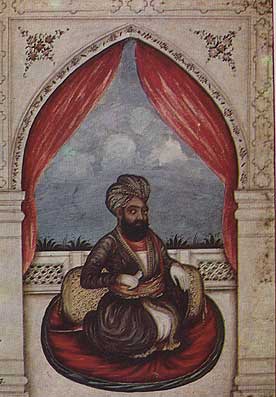
Nawab
Mahammad Akbar Khan was the favourite son of Amir Dost Muhammad Khan of Kabul.
Muhammad
Akbar Khan was the treacherous murderer of the British envoy, Sir William Macnaghten,
whom he received with his (British) staff (apparently) to meet him and his chiefs
some 300 yards from the British cantonment: no sooner had they dismounted at the
place of conference than the three officers on the (envoy's) staff were seized
and carried off on a horse-back by Akbar Khan's different trusted chiefs to a
distant yard, surrounded by their rescuers.
Two Captains, Lawrence and Mackenzie,
reached into safety, while Major Trevor's horse stumbling, he was shot down and
killed by angry mob.
In the meanwhile Muhammad Akbar had seized the envoy by
the arm, calling, "Follow me." But Sir William Macnaghten resisted and
a cry being raised that the British troops were coming, Muhammad Akbar shot the
envoy and rode away.
There is no doubt that Muhammad Akbar had not deliberately
planned the murder. But his hands were forced by the resistance made by the envoy.
Muhammad Akbar was anxious to take the envoy and his staff prisoners and having
them in his power, he could compel the British force to retire from Afghanistan.
On
5th January (1842) General Elphinstone having agreed to return to India, left
Kabul with 4,000 troops and 8,000 men. From the moment they started on their march,
they were harassed by the Afghans from Khurd Kabul to Jalalabad and no threat
from Akbar Khan or his chiefs could restrain the tribesmen from cutting off all
stragglers.
A great number of European officers and men as well as women and
children were made prisoners on the march. Akbar Khan insistedon their being made
over to him and he kept them imprisoned for eight and a half months till General
Pollock reached Kabul. Akbar Khan's object in doing so was to keep them as hostages
for the safety of his father, as well as his wife and children the latter being
in British hands.
Sometime after this, Muhammad Akbar Khan besieged General
Sale in Jalalabad and in the beginning of April (1842), three days before General
Pollock's army reached there, Sale sallied out and dispersed the Afghans in open
plain.
Akbar Khan's efforts to check General Pollock's advance on Kabul were
fruitless, and his own selected officers in charge of the British were bringing
him back to Kabul when an escort under Richard Shakespeare effected the release
of the prisoners.
Muhammad Akbar Khan died in February 1847 at Jalalabad, presumably
poisoned by his doctor.
SARDAR
FATEH KHAN TIWANA
In 1821 Maharaja Ranjit Singh
marched in person on Mankhera, a very strong, large walled town, with a cordon
of twelve forts in the middle of the desert between the Chenab and the Indus.
The
assistants of the chief of Mitha Tiwana, Qadir Yar Khan, and his two sons, Khuda
Bakhsh and Fateh Khan and their sepoys were ever great and the Maharaja was so
struck with their handsome, manly appearance, their bold bearing and their gallant
fighting, that he enlisted some sixty of them as his body-guards, which was first
of all commanded by the elder brother Khuda Bakhsh and later by his brother Fateh
Khan.
After a time Raja Dhian Singh, the Prime Minister, who recognised Fateh
Khan's courage and unscrupulousness, thought that he would make a useful employee
of him and took him into favour and gave him different appointments, in each case
increasing his advantages and giving him opportunities of extorting money until
Fateh Khan became very rich.
He was employed at times beyond the Indus, at
Bannu, Swat and Kohat where he ruled with a rod of iron.
The future of Fateh
Khan seemed assured, when one day his friend and patron Raja Dhian Singh and Maharaja
Sher Singh fell by the Sandhanwalias. Fateh Khan who till that moment had been
hiding close by the side of the doomed Minsiter, seeing that something
was
wrong, dropped behind the cavalcade and so arrived at the gate of the fort in
time to be shut out from the scene of murder. Fateh Khan prudently retraced his
steps and concealed himself in the city until the death of the Sandhanwalias made
it safe for him to reappear.
Raja Hira Singh, the son of the murdered Prime
Minister, openly accused Fateh Khan of being an accomplice in the conspiracy and
put a price on his head. There was no reason to believe the charge made for by
the Raja's death. Fateh Khan could gain nothing and might lose all.
He escaped
in disguise from Lahore and fled to his native area, whither he was followed by
a force sent to arrest him.
He then crossed the Indus to Bannu, and when the
Sikh troops retired, he recrossed the Indus and called the Muhammedans to arms
and soon gathering a large following, he scoured the cavalry and defeated several
troops sent against him.
When, at length, Hira Singh fell from power, Fateh
Khan hurried to Lahore, where he knew that he would be well received by the new
Prime Minsiter Sardar Jawahar Singh, whose battles he had fought against the late
administration. He was not disappointed. Jawahar Singh made him ruler of Mitha
Tiwana country and portions of Jehlam and Rawalpindi and also the whole of Dera
Ismail Khan and Bannu. But Jawahar Singh had not given Fateh Khan the power and
the position for working.
The Prime Minister had a dangerous rival in the person
of Prince Pashaura Singh, the reputed son of Ranjit Singh, more generally regarded
as the best man to sit on the throne. Pashaura Singh had gained possession of
the fort of Attock, and Fateh Khan and Sardar Chatar Singh Atariwala were ordered
to march against him. They found it difficult to take the fort of Attock by assault:
so they proceeded to negotiate with Pashaura Singh, promising to escort him to
Lahore if he would give up the fort. To these terms he agreed and two days afterwards,
they seized and strangled him and cast his body into the Indus.
After this
treacherous murder, Fateh Khan took up the governorship of Dera Ismail Khan. He
had the chiefs of Tonk called to his Durbar, had them suddenly seized and they
and their retainers were cut to pieces.
After a time, the Multanis
and other Pathans rose against him and drove him across the Indus.
Fateh Khan
was summoned to Lahore by the new Prime Minister Lal Singh who had succeeded Fateh
Khans' friend Jawahar Singh. Lal Singh found a large sum of money deficient in
the assets (obtainable from him). As he refused to pay (the amount recoverable
from him), he was confined. (Later), he was released from imprisonment sometime
after the British army occupied Lahore.
After the Multan rebellion of 1848,
Lt. (Herbert) Edwardes thought that he would be of use on the frontier and proposed
that he should be sent to Bannu of which he had previously held charge.
The
Sikh force at Bannu was (already) thoroughly disaffected. The appointment of Fateh
Khan increased the dissatisfaction, and on receiving the news of Raja Sher Singh
Atariwala's rebellion at Multan, the Sikhs rose in mutiny, and drove Fateh Khan
out of the town. He entered the fort.
Fateh Khan might have held the fort,
but there was no water supply. The defenders were soon reduced to the last extremity
and were compelled to surrender Fateh Khan. The Sikhs would never have given him
quarter, even if he had designed to ask for it. (Under these circumstances), Fateh
Khan was shot at the gateway of the fort.
The more the character of Fateh Khan
is regarded, the more he will appear unworthy of our admiration. He was brave
indeed, but what is courage unless allied with generosity and hallow? What was
that courage worth, which could murder Prince Pashaura Singh in cold blood and
could have the gallant chief of Tonk done to destruction? It was only in times,
when might was right and honesty was professed by none, that such men as Fateh
Khan could become distinguished! He was proud, treacherous and a ready tool for
the commission of any crime. There is no virtue that can be claimed for himself
a superior liberality, which was generally indulged, not at his own expense, but
at that of the State.
Fateh Khan died defending the fort entrusted to him,
but his honourable end to a life of violence and bloodshed, should not induce
men to forget or to extenuate his many crimes!